Text
The Archon’s Review of The BattleCats
The Battle Cats is a defense game for mobile devices published by PONOS. You play as the commander of the Battle Cats, a world-conquering army of misshapen feline beings who travel from nation to nation, destroying all human edifice in their wake. Still, your warmongering horde isn’t nearly as terrible a scourge as, say, global climate change, so at least there’s that...?
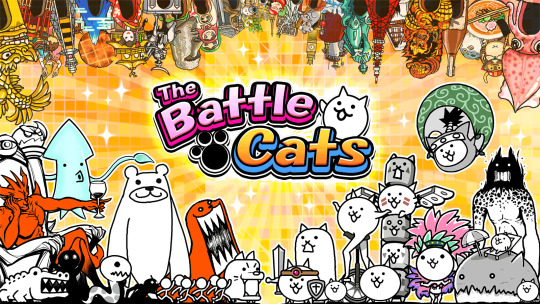
So I think I first saw this game when Markiplier played it a while back, and I have to say, it really helped me to internalize the way a lets-player can make a game seem, versus how the game actually is. Which is not to say that Markiplier lies or misleads his audience or anything like that; I actually really like Markiplier! My point is that if you went by the promotional material online and the way the game is presented to potential players, one might get a somewhat distinct impression, one distinct indeed from what the game is actually like.
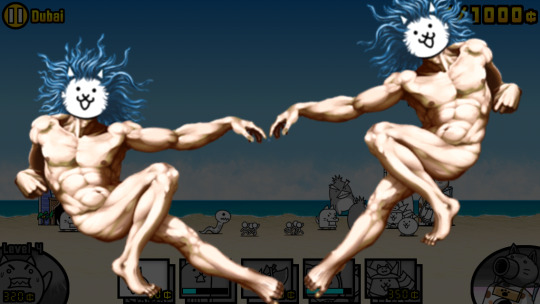
(If I was marketing for this game, this is probably what I’d put front and center)
Basically this game is in the same vein as so many “gatcha games” you see on the app store. Admittedly, it’s a pretty good one, and the lack of any multiplayer elements of any kind removes the self-destructive impulse some people may experience trying to roll for the best things so as to compete with others.
So what is this game, exactly? Basically, your job during each level is to spawn cats to saunter toward your enemy’s base and thwack it to death, meanwhile preventing your own base from meeting a similar fate. Playing the main campaign unlocks new cats for you to spawn in the game, as well as XP to upgrade your base and your cats. It’s somewhat too simple for me to say much about, honestly.
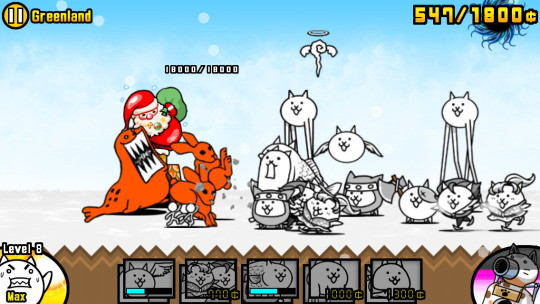
(This is the core gameplay. Fun and exciting, yes, but that’s all it is.)
Unfortunately, that simplicity also opens it up to a lot of criticism; if there was more to say about it, I could perhaps talk more about its good points, but those kinda begin and end with the gameplay.
So here comes the critique balloon ready to pop all over this thing. First off, there are several sudden and unnecessary difficulty spikes, and you’ll hit walls pretty often. The game will, of course, say that you can replay older levels to grind XP, but A) that’s bollocks, and B) the older levels give you less XP the more you play them, resulting it becoming even more bollocks over time. What the game actually wants you to do is to spend real-world money on cat food, items, XP, and tickets to roll “gatcha” to get new cats.
Second, the game gets real repetitive real quick. After you complete the first campaign, the game opens up a little, giving you more features, but after that, it’s the same grind over and over and over again, sans some over-difficult optional nonsense..
Tying into the second problem is something I mentioned earlier. See, “gatcha” games always stick to you more if you have friends to play them with, or even other players to compare yourself to, and without any multiplayer aspects, there’s really no reason to get the best cats except to beat the repetitive campaign missions.
Basically, while the weird-looking cats and creatures might provide momentary entertainment, you will eventually hit a wall or become bored with the repetition, or just lose interest without anyone to play with. I suppose if you just want to look and play with fucked-up looking feline animals, then this’ll do it, but you could probably just scratch that itch by making a warped Khajiit character in The Elder Scrolls IV: Oblivion and call it a day.

(I do empathize quite a bit with the narrator though. Keep writing, mysterious narrator man!)
#video games#video game#archon reviews#review#video game review#lane defense#defense#mobile games#the battle cats#ponos
0 notes
Text
The Archon’s Review of SOULCALIBUR VI
SOULCALIBUR VI is the seventh installment of a venerable series of fighting games that started with Soul Edge. The series is created by BANDAI NAMCO Studios, more specifically by Project Soul. In the 16th century, rumors of a powerful sword, Soul Edge, have emerged. Many seek it, some to wield it in service to a greater cause, others in service to themselves. However, only a few know of the truth, that Soul Edge is an evil, soul-devouring blade that slays every wielder to comes into its possession. Fewer still know that Soul Edge has a twin, the spirit sword, Soul Calibur. In the midst of this turmoil, many warriors fight for good or evil, order or chaos, and future of the world and all its souls hangs in the balance...

While I was never very good at fighting games in general, I consider myself passing skilled in the specific arena of 3d fighters. I’ve played the shit out of Soulcalibur II, Soulcalibur III, and even Soulcalibur IV. When I heard that another one of these was coming out, I was rather quite pleased, especially since it’s out on Steam.
So, in case you haven’t heard, the Soul Calibur series is a tale of souls and swords, eternally retold. In this case, it really is a tale retold, as it is a soft reboot of Soul Calibur, which came after Soul Edge. What this really means is that we get the tragic backstories of certain characters as they were told in SC, plus the tragic backstories of other characters as they were told in SCII and SCIII, and some stories were changed entirely, just for funsies, as far as I can discern.
“But Archon,” I hear you ask, “this is a fighting game. Story would have been shunted faaar down the priorities list; why are you talking at length about it?” And to that I would ask you how you got into my house. But also, I would say that the Soul Calibur series has always put a whole heaping helping of plot and story in its titles, and that story is often... interesting, but not skillfully executed, leading to some... peculiarities.
I’ll start with the main story. They call it “Libra of the Soul”, and it’s called such because it uses a set of scales (or “Libra”) as a metaphor for their moral choice system. So you’d think that if they’re naming the main campaign after the moral choice system, then that system would be executed well. You would be wrong, sadly. Basically, what happens is that every so often, usually after a fight, you’ll be presented with a binary moral choice. Some of them make sense, such as “Steal this defeated bandit’s weapon, or tussle his hair and tell him not to do bad things anymore”. But the decision that sets the tone, the very first one, in fact, is completely bonkers. See, you’re in a dream sequence, and you’re presented with two swords, one golden and one azure. You’re told that the golden one represents freedom and the desire to forge your own fate, while the azure one represents a desire to impose order and harmony on an inherently chaotic world; you’re then asked to choose one. Naturally, because I am a red-blooded, eagle-fucking, burrito bowl-eating American patriot, I picked the golden sword, after which the game literally told me that I was “Aligned with the darkness.” Oh I’m sorry, I didn’t realize that wanting to forge my own destiny made me a bastard! And there are plenty of other choices that the game boils down to either “good” or “evil”, despite being more complicated than that. Worse yet, the post-game content, as far as the morality goes, is literally just picking from those fucking swords over and over again. So why is it even here if it’s so poorly presented? Well, the only things of substance that seem to change if you’re good or evil is which of the two plot-important swords your character wields in certain cutscenes, and a particular line your character spouts after a post-plot optional fight. The game will tell you that certain optional fights are only available to characters who are either good or evil, but I don’t buy that, frankly. And certain weapons have an increased rate of scoring critical hits depending on your alignment, but realistically, you can just wield the one with the biggest average damage and you’ll be fine.

(This question about fate is the only moral choice in the game with a neutral option, and frankly, it isn’t even really a moral choice, in my humble opinion.)
While Libra is the story of your OC (more on that in a bit), the game also infuses the main cast with individual stories of their own. And it even does something quite revolutionary for fighting games: it creates a central canon and has the cast all tie their plots around it, so that you don’t have a case where theoretically one character’s ending is just as canon as another’s, unlike most fighting games I’ve played and seen. However, this creates a couple of glaring issues. First, it means that the main cast can’t be fighting each other all the time, because they’re all in different places and times. To solve this issue, a not-insignificant number of plot relevant fights are against total randos who contribute nothing to the story. This contributes to the second issue, that is to say that any character’s plot outside of the main canon feels tacked-on and unnecessary. Most of the characters don’t even interact with the main macguffins at all. In addition, many chapters are extended dialogues instead of fights, which seems extremely misguided seeing as how we are here for the fighting. One particular instance that really got my goat was the character Zasalamel, who’s entire plot is given via monologue, without a single fight. It honestly made me wonder what I was even there for.

(Now, when the game decides to go full cutscene, it’s pretty stunning)
So a fighting game has a poor plot; and in other news, bears remain Catholic. I bring attention to it, however, because SCVI just has a shitton of plot, more plot than is socially acceptable for a fighting game to have. This makes me wonder something. A thought, you see, crept into my brain pan as I traveled across the world map of Libra, stopping intermittently for plot-relevant fights and sidequests which I had little personal investment in. That thought being, “Would Project Soul be more comfortable just making RPG’s?” I mean, the Libra mode has all the trappings of an RPG: an expansive world map, random battles, tons of sidequests, weapon and item drops, a levelling system, and expansive scope, a binary moral choice system. And yet it was bound, or maybe cursed, to be a fighting game. So, Project Soul, if you guys happen to read this ever: Would you guys be more comfortable making RPG’s? Because I can’t speak for other people, but I would play the shit out of a Soul Calibur RPG. Just something to think about during the next company meeting when some bigwig from BANDAI NAMCO is droning on about how you’ve gotta make Sophitia twenty percent more “milfy” or how you’ve gotta make Siegfried sixty percent more emo.
So, lets veer away from plot and get more mechanical. I’ll start with the character creation; and let me just say that I’m actually more mixed on it now that I’ve had time to reflect. When you first create a character, the game gives you a list of fantasy races to choose from (my idea from when I was like, 13 years old, but go off I guess), and you can be as fat or as skinny as you want to be, and you can modulate your character’s voice to be however you want it to be. All in all, first impressions were good. However, I was disappointed to learn that you couldn’t be a female lizardperson. In fact, several races lack female options, which really irritated me, because I had an awesome idea for a lizardwoman character, but I couldn’t use the female clothing options to make that idea a reality, so I just had to use male clothing options and headcanon my own OC as a female, even though it said “Male” on her sheet. What chuffed me even more was the fact that you could have a female skeleton, skeletons being the one entity I could imagine skipping out on gender designations for. In addition, they still havn’t brought back the custom character styles from SCIII yet, nor have they allowed you to make your own, forcing you to use a pre-existing style, which, as has been stated before by better critics than I (notice me Yahtzee), is basically just crafting a custom model for an already existing character. This wouldn’t be a problem if they just brought back the custom styles from SCIII or let us create our own style in the vein of Mortal Kombat: Armageddon. However, the creator may be more robust than I give it credit for here; I did manage to make some characters that I thought were pretty awesome, and plenty of people have bent it toward the ever-noble goal of transplanting Pokemon into the Soul Calibur universe. Basically, if you want to create a fun and interesting-looking character, great. If you want to have a custom moveset, or if you wanna make a big-tittied lizard play a female lizardperson, so sorry.

(Seeing this screen actually brought me no small amount of joy.)
Now, what about the mechanics of play? Well, this is the reason I, despite all my earlier criticism, really like this game. The fighting is solid, each move having appropriate weight and impact. The controls are responsive and smooth, even at high graphical settings (online play notwithstanding). Guard impacting makes a triumphant return after its apparent disappearance in SCV, although, it seems like the timing on it is a little more lenient than in previous installments. Soul Charging is its own little cutscene and knock-back effect, instead of SCII, where I remember Soul Charging being a liability that no one used. There’s also this new thing called a Reversal Edge, where you and your opponent both press a button and the person who pressed the best button wins. Okay, it’s a little bit more complex than that, as when the two players tie, they do it again, except verticals win, except if both players did a vertical, in which case the instigator wins, so the whole process ends up being like speed Rock-Paper-Scissors with extra rules. People seem mixed on whether this is a welcome edition to the formula or if it’s pointless and dumb, but I personally like it. If nothing else, it’s flashy as fuck. The move list also seems slightly more simplistic, although that could just be down to me finding all my favorite moves early.
Now for small potatoes and nitpicks! They changed many of the voice actors since SCIV, although, since I didn’t play SCV, I wouldn’t know if these are recent changes. While I really didn’t dig most of the choices, I will admit that Siegfried’s VA was spot on, capturing a sort of perfect middle ground between tortured hero and lovable wangsty-man. I remember liking the old announcer more too, although I fully admit to having nostalgia goggles on for that.
The amount of objectification of women in this game is frankly intense, although, if you’ve ever seen the models for the characters of Ivy the dominatrix or Taki the ninja, that shouldn’t surprise you. What may surprise you is that clothing damage is back, which is weird, because while in SCIV, clothing damage had a purpose, as certain pieces of clothing informed certain stats, it doesn’t seem to serve any mechanical purpose here. However, it does mean that the men can get in on the sexualization action too. In fact, I’ll tell you all a little secret: Raphael, the fencer, has a move that can tear off all the clothes of any other character, leaving them in their skivvies. Step one: Soul charge. Step two: Use the Triple Botta In Tempo (forward+vertical, then vertical vertical vertical vertical...). If you’ve completed step one, and the enemy hasn’t blocked, Raphael will do this kind of Zorroesque maneuver and wham bam thank you mam, all your opponents’ clothes fall off. Do it on Mitsurugi the samurai and...
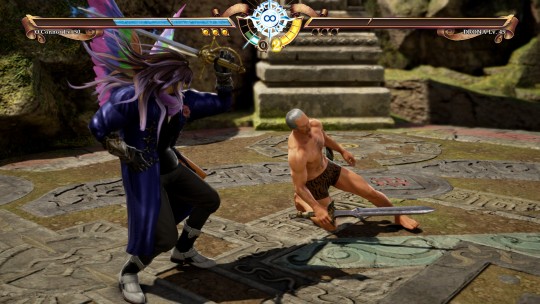
(Both of these characters are only based on the mentioned characters, but I hope it demonstrates my point. On the left, my Raphael-style character.)
One last point, and one that’s been made to death: the guest characters. While Geralt from The Witcher series made sense, being at least aesthetically consistent with the other characters, BANDAI NAMCO are apparently going to put in 2B from Nier: Automata, and frankly, that doesn’t make much sense to me, but I may very well be in the majority on this, so I won’t say too much more about it, since this gripe is even more subjective than usual.
To sum, would I recommend Soul Calibur VI? I would say so, if for no other reason than that the game mechanics are solid, and frankly, if I take the nostalgia goggles off, I have to admit that this one is the best Soul Calibur so far. In addition, this character creator is pretty robust, if you don’t mind not being able to do very specific things, such as making a big tittied lizard. While the unnecessary sexualization and weirdly grandiose story can bog things down for some, I’d still recommend it for the gameplay alone.
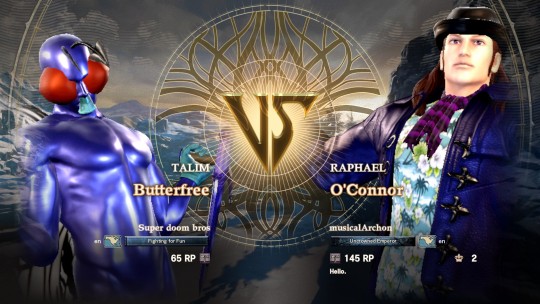
(No big tittied lizards, but Pokemon/Human hybrids are okay. Sure.)
#archon reviews#video games#video game#review#soul calibur#soul caliber vi#soul caliber 6#fighting game#fantasy
0 notes
Text
The Archon’s Review of Tavernier
Tavernier is a visual novel/management game from a group that (somewhat awkwardly) calls themselves “From the Bard”. You play a Tavernier, or a tavern owner, in a stock fantasy world, replete with adventurers, rogues, peasantry, and all manner of patrons. As the weeks wear on, however, you being to uncover a secret conspiracy involving all the cliques in the town you’ve set up in, one that goes all the way to city hall. Will you suss out the conspiracy? Or will you just shrug your shoulders and return to work?

So, I have a bit of a soft spot for management games. I mean, it’s not like I go out and seek them like I might with an RTS or an RPG or a TBS or an ABCDEFG or an IRS, but I’ve never played a management simulator that I didn’t like. In many cases, a management sim is just the resource management aspects of a strategy game boiled down to their essential components, and sometimes Bioware sticks their head into the room and throws NPC opinion meters into the mix, or else something similar. Basically, management sims are strategy games boiled down, and I can get down with that.
So, Tavernier then. I’ve always kinda wanted to be a barkeep, and I might have pursued that goal if it weren’t for the terminal case of social awkwardness and anxiety I have to deal with on a regular basis. As it stands, this game gets somewhat close to my goal, although the actual management aspects of this management game have been significantly boiled down even more than usual.
The main thing to do in the game is make money, as might be expected. You do this by setting up a menu that your customers will appreciate, selecting ambient music for them, and putting up decorations for them. There are several different types of customers, each of which like different things. Rogues, for example, like dairy foods, while guards prefer meat, and folks prefer fruit. Each type also has a certain style of music they enjoy and certain decorations they like. The objective then, is to maximize your income by optimizing your tavern for a specific clientele (and now I sound like some kind of corporate managerial wankpot). That sounds involved enough, but it really isn’t. Just make sure your gold at the end of each week is greater than your expenses for that week and you’ll be peachy keen, and even if you don’t, all that’ll happen is a guard will show up and wag his finger at you.
Throwing a wrench into your operations, however, are a couple of factors. First, you have to decide on whether you want to be a “Professional” alcohol enabler, or a “Cool” baahrkaeep. Being more professional earns you more discounts on taxes and food, and being more cool gets you more customers. It’s not so much a binary moral choice system as much as it is a binary personality choice system. The second thing is that each week, an event will happen, and usually, you’ll have to make a choice about it. Sometimes, they’re good! But other times, not so much.
The game also has a story; a story about a mystery in the village, which you get to solve! Eventually. SPOILER WARNING, I GUESS. Each month, the mayor takes a miscreant from the village, and incidentally, from your tavern. When you investigate, you’re given access to a secret meeting, and eventually you find out that the mayor is being impersonated by a djinn who is fueled by human sacrifice. So you have to get together your friends and customers and oust the villain!
Now, I actually really like the story, but not because it’s a great story. Instead, I like it because it neatly utilizes all of the game elements. You need to ingratiate yourself with one of the several factions in the game so you get access to the meeting and later on to gather together an army, you need to get on one end or the other of the personality scale to prove you’re not too indecisive to do what needs to be done, and you need to gather enough gold and/or mana to supply your army and win the day. It’s all very ludonarratively synchronous, (now I sound like a smarmy video games journalist) because the plot is noticeably advanced by your playing the game well.
However, I do have a couple of problems with the game. First, the art style, while not uninspired, does get a bit grating after a while. Like, it’s as if someone leaned on the “Stock Fantasy”, and “Thick Black Lines” settings on Photoshop. Or maybe it’s because once you optimize your tavern you see the same customers over and over and over again and it gets tedious. I guess more character models wouldn’t have been remiss.

(This is the game, basically.)
Second, discovering the mystery and completing the story is really easy. I did it on my first go, starting with an unoptimized tavern and a shit menu, and by the end I had only optimized out of necessity and I still had a shit menu.
Last, the game is criminally short. You can bang out a run in an afternoon, easy. Sure, there’s an infinite mode afterwards, where you can just serve customers forever, but that kind of thing gets boring fast, especially when optimization is the name of the game. For scale, I took more time to read Lilith Grimm’s seminal work, “The Dildo in the Basement”, than I took to complete a run of this game. So I did three runs, and it was just as easy each time.
I can’t dock the game points for this next bit, because, sadly, humor is subjective. See, the game occasionally makes a funny to the effect of, “Wow, this is a video game we’re playing, innit?” For example, one event has an adventurer skip your dialogue and steal your goods while you stand motionless and helpless. Then, to drive the point home, the adventurer ruminates on how awesome it is to be the protagonist of a video game. Another hilarious joke comes when you meet the leader of the celestial beings (I know that sounds really impressive, but it isn’t). She goes by Ms. Sue, and introduces herself as Mary. I’ll let you figure out the joke. Like I said, I can’t dock points from the game because humor is subjective, but I found it tiresome at best.
I want to like Tavernier, but I found it kinda insubstantial, and the art and humor grated a little. I’m not going to play it again, but I suppose I can give it a tentative recommendation, on the condition that you’ve got an afternoon to kill and a hatred of djinni.

(Honestly, with a look like this, it’s a wonder this guy managed to get into office, even before he was supplanted by the djinn.)
0 notes
Text
The Archon’s Review of Danganronpa: Trigger Happy Havoc
Danganronpa: Trigger Happy Havoc is the first in a series of visual novels with an investigative theme and FPS elements made by Spike Chunsoft CO, Ltd, and Abstraction Games. You play as Makoto Naegi, who has just been accepted to the super-prestigious high school, Hope’s Peak Academy, via random lottery, making him the “Ultimate Lucky Student”. However, upon arriving at the school, he suddenly falls unconscious, and wakes up in an unfamiliar classroom. He soon meets the other fourteen “Ultimate” students, each of which have their own unique talents and abilities. Before they can all get comfortable, they are informed by means of small evil bear that they cannot leave the school, ever. However, the bear specifies that there is one and only one way to escape the school: they must kill another student and get away with it. Thus begins a horrible game of life, death, and detective work as you struggle not to be killed, and to make friends with your fellow students before they kick it. Make sure your argument gun is loaded with truth bullets and fire away!

So I was playing NEKOPARA: Vol. 1, Or more accurately, getting through NEKOPARA: Vol. 1, when a good friend of mine decided to gift me this game out of some mixed sense of pity and duty. His logic was that A) N:V1 wasn’t very good, and B) everyone should play D:THH instead. I will agree on his first point certainly, and while his second point is still debatable, I will say that this game is quite good.
This assertion of mine is actually quite strange, for reasons I’ll get into, but to put is simply, the actual gameplay parts (as opposed to the visual novel bits) are interesting in concept but only okay in execution. So why might I say that this game is quite good, despite being mechanically middling? Well, you’ll just have to read the rest of my review, won’t you?
The game is divided up into chapters, each of which has a “Daily Life” and a “Deadly Life” section. The “Deadly Life” sections are where the actual gameplay bits take place; and this can be further boiled down into two sections. First, someone gets iced, usually in a gruesome fashion. It then falls to you to investigate the murder, by talking to the other students and finding physical evidence. After that’s done, the second part of Deadly Life begins, the Class Trial. Basically, you and the other students try to determine who did the deed, so that the culprit can be punished instead of the other students. And by “punished”, I of course mean “slaughtered mercilessly, if not creatively”. Don’t worry if this all feels like spoilers, the fucking bear tells you all this after the first murder.
The investigation bits do feel suitably detective-ish, and I like how some of the ancillary evidence is brought up by other characters, as it makes them feel like they’re contributing meaningfully to the investigation; but I take issue with the inorganic method by which the game delivers evidence to you. For one thing, there are plenty of times where the game outright tells you where to go and who to talk to and what to do to make more evidence appear, even after I had already figured out what to do beforehand (more on that in a sec). In addition, you can always tell when you haven’t found enough evidence, because when you do find enough evidence, the godsdamned bear starts the trial for you, and when you figure that out, it just becomes a matter of poking around until trial time, even if the evidence you have seems anemic or meaningless.
So I’m going to diverge for a moment, and talk about something that really frustrated me throughout the entire game. There are specific moments that crop up quite a few times in the game, which I like to call, “Makoto Naegi is a colossal moron and I want to punch his stupid face” moments. These are moments where something is incredibly obvious to me, almost insultingly so; but Makoto, being a clueless human being, doesn’t figure it out until far later. It’s almost gratifying to watch Makoto catch up to you, dialogue box by dialogue box, but whatever satisfaction you might glean from being smarter than the protagonist is not worth the frustration one would experience having to actually play as them.

(Except in this part. I was right there with him here.)
This brings us to the so-called “Class Trial” portions. The objective here is to figure out who the killer is and prove it. If you succeed, they’ll be killed by some gruesome and ironic means. Fail, and everyone except the killer perishes, but the killer gets to go free. You have to bring up evidence to counter the assertions of your fellow students, and this is where the “Trigger Happy Havoc” subtitle begins to make more sense. See, during what the game calls, “Nonstop Debate”, the evidence you gather in the investigation manifests as “Truth Bullets”, which you fire at the other students’ statements, which fly across the screen, whenever they make a contradiction or get something wrong. In addition, your marksmanship will be called upon in two other minigames during the trial, “Hangman’s Gambit”, and “Head-to-Head Battle”. In Hangman’s Gambit, you have to shoot letters as they come toward the screen to form a word that’s relevant to the case. Head-to-Head Battle is a rhythm game, where you have to take aim and shoot down your opponents phrases and panicked cries by clicking to the beat.
I have a few problems with each of these minigames, and while individually, they may seem like small potatoes, together they form a big, irritating starter potato. The first issue I have is with the Nonstop Debate. Specifically, a problem I often had was that I knew exactly what I wanted to contradict and how I wanted to contradict it, but I was never sure which phrase to shoot at and which Truth Bullet to use. Basically, I had trouble figuring out what the game wanted me to do to progress the trial. This gets especially frustrating when you gain the ability to click and hold on certain phrases to save them as Truth Bullets. You’d expect the game to want you to save a phrase early on to use as a counterpoint later on in that round of Debate. However, more often, the game wants you to hold onto a phrase, wait for that round to end, then use the stored phrase on an earlier part of that round. When I finally figured this out, I remember making a face somewhere between a sneer and the face one makes when they finally figure out something that should have been blindingly obvious, but is no less a stupid thing to have to figure out. I can make some very specific faces sometimes.
As for Hangman’s Gambit, it’s just plain unnecessary sometimes, and other times, the word is one you haven’t specifically heard thus far. As an example, if you are being asked to guess a four-letter word, and you get two letters for freesies, it begs the question: why bother making us do this if the answer is blindingly obvious anyway? The opposite problem also exists; the topic of discussion was a certain mental illness, and the solution to the Gamble was a completely different, hitherto un-mentioned mental illness.
My major problem with Head-to-Head is that it’s confusing, but somehow too easy, especially when you get the ability to engage “Fever Mode” which makes it so that you don’t have to tap to the beat at all, and can just mash buttons. That’s not exactly gameplay so much as it is what I do when I play Blazblue.

(I will say that the minigames sometimes give us the most unintentionally funny moments in the game. Like when the shitty rich guy is flabbergasted that someone could know something he doesn’t.)
You might think I’m down on this game, but if you can recall around seven paragraphs or so, you’ll remember that I like this game. Quite a bit, in fact. This is primarily, I think, because of the art style and the characters in equal measure.
The art style relies on a lot of dark lines, almost as though it was drawn with felt-tip, while some of the cutscenes are more smudgy, almost as though they were done with charcoal, somehow. The character designs are often angular and exaggerated, but always expressive. They can be a little in-your-face, but this actually works to the advantage of the art style, enhancing the already genuine-seeming emotions being displayed onscreen.

(Also, there are a lot of written-out sound effects, which I found charming, if nothing else. I could never figure out why this person’s tongue was as long as it was.)
As for the characters themselves, there’s something about them that makes you want to know about them, even beyond the mechanical benefit that furthering your relationship with these characters nets you, that is to say, the extra abilities you can use during the trial minigames. More than that, the characters have a way of getting you invested in their stories. I think it has to do with a simple thing: secrets. Each character has secrets or goals or insecurities that you don’t get right off the bat form meeting them, and once you first interact with one of them, you’ll want to learn more. Even the most hatable characters (and trust me, there are a few), will get you invested, and desirous of more information about just who these people are. It makes it all the more upsetting when for one reason or another, a character that you had been building a rapport with dies in some gruesome manner. Because you’ve invested not only time, but emotion into learning these characters, watching them perish is downright heart wrenching to behold, ridiculous execution scenes notwithstanding.

(This scene fucked me pretty good.)
However, I will nitpick a little here, and say that when the villain finally reveals themselves, they go on a massive villain rant that goes on waaaaay too long, and I honestly thought I was gonna have sit there and take it just to watch them win. Without wishing to spoil, that’s not exactly what happens, but having to sit through that gave me a new appreciation for the phrase, “captive audience”, and it kinda brought the ending down for me a little bit.
I should also point out real quick that the game’s attitudes toward gender and gender expression is very much Japanese. There’s a scene where you literally cannot leave the area until you creep on the female students in the bathhouse. In addition, the fact that one of the characters cross-dresses is used as a plot point, and while they aren’t explicitly trans, I can, with a modicum of confidence, say that the depiction of the character in particular may make some people uncomfortable.
So, all in all, I would recommend Danganronpa: Trigger Happy Havoc, with the caveat that while the minigames are mediocre, the plot and characters save it. And while I won’t replay the actual game, I will point out that there is a mode you unlock after the main game that’s just the characters, without the detective stuff, so that’s something for those of you who don’t manage to be maximum friends with certain characters before they kick it. If you like Phoenix Wright... and shooting... and Survivor... maybe you’ll like this game? I just realized how weird the premise is when you compare it to other things. Still good though!
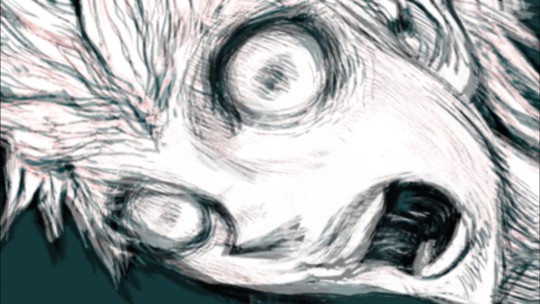
(Hello darkness my old friend...)
#archon reviews#review#video games#video game#visual novel#detective#danganronpa trigger happy havoc#danganronpa
0 notes
Text
The Archon’s Review of Vampire the Masquerade: Bloodlines
Vampire the Masquerade: Bloodlines is a modern fantasy role-playing game developed by Troika Games and published by Activision. You play the role of a newly sired vampire in 21st century L.A. Your sire is executed on the orders of Sebastian LaCroix, Prince of Los Angeles, and you are then forced to do LaCroix’s chores. Thus begins an adventure through the seediest parts of Los Angeles as you attempt to recover a mysterious sarcophagus, fight off the attentions of the violent Sabbat, and decide where their loyalties lie. Oh! Also, don’t murder too many “innocent” humans, or you’ll turn into a monster or something.

Man, I wish this game got at least half the love it deserved from... well, from everybody. Or rather, I wish it had received more love from Activision and the public, and less from Troika. After all, it was Troika’s excessive design scope, combined with Activision’s apparent indifference and callous deadlines that made this game far less than it could have been. It’s been more or less left to fans to improve and even in some ways “complete” the game after its release.
All that said, however, the game as released is quite good, especially in the writing department. The story has you navigating vampire society, completing various missions for the clandestine Camarilla organization (not to be confused with Kaiser Wilhelm II’s circle of advisors headed by Otto von Bismarck), and more specifically Prince LaCroix, and has you eventually picking a side in a decades-spanning conflict between the rebellious Anarchs, and the Camarilla itself. The world is rich and enveloping, with characters that feel like real people even if you only speak to them for a little bit.
Before I go into greater detail about the story and writing, let’s talk about the mechanics of play, which are... ehhh-but-kinda-okay??? I’ll talk about your vampiric abilities first. Basically, as you increase in power, you’ll acquire greater powers as you attain higher levels in “disciplines”. Each vampire clan has a set of three disciplines at its disposal, ranging from superhuman strength and speed, to invisibility and extra-sensory perception, to literal magicks and the ability to afflict other people with madness. As you level up and put character points into those disciplines, either you get new powers, or the power of the discipline itself becomes greater. For example, more points in Thaumaturgy (otherwise known as Literal Blood Magick) gets you additional spells to cast, while putting additional points into Potence (otherwise known as Swoleness) makes the affect of the discipline greater when used. All of that, that being the character progression and the gradual increase in power over the course of the game, that all works pretty well. You can actually feel your character’s increasing power over the course of the game.
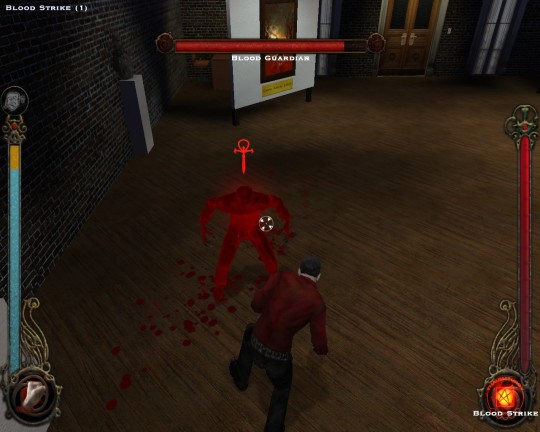
(Pictured: Me trying not to get wrecked by a surprise boss. Punching it worked well enough.)
However, I will criticize a couple of things. First, when selecting disciplines to use, the default is using the mouse wheel, which is fine, I suppose, when selecting guns in a first-person shooter. But when trying to sift through ~7 abilities, each of which does different things, it can be something of a bugbear. I died at least a couple of times when I was trying to select the spell that makes nearby enemies barf their blood vessels out, and I accidentally selected the power that makes everything glowy for a bit. I only found out that you could (presumably) assign disciplines to the number keys very late in the game.
Second, combat difficulty can be a bit wobbly. Against human opponents, the difficulty depends almost entirely on whether the enemies have high-powered automatic guns. If yes, then it becomes a game of getting the enemies to come at you one-by-one for strategic beatings. If no, then feel free to run right into the middle of them and beat on all of them. Make sure to save one human for feeding though! Feeding regenerates your health and powers your blood gauge, which acts as a sort of mana bar for your disciplines. And since you can feed freely in combat areas, there’s no reason not to kill every human enemy except one, then get all your health and blood back from them.

(Omnomnomnom...)
Against other vampires, however, it’s a different story. Most vampire battles are boss battles, so it makes sense for them to be difficult. But the battles against regular vampires can also be nightmares if you’re not careful, and even if you are. Here, you have to be a bit more conservative with your disciplines, because for some reason, the game prevents you from committing diablerie (which I feel perfectly entitled to), so you can’t get your blood or health back from them. One thing I would recommend when fighting other vampires: use edged weapons. Even if your edged weapon and your blunt weapon or gun supposedly do exactly the same damage, even counting lethality ratings, you always want to use edged weapons against vamps. For some reason, edged weapons always do more damage to vampires, and stagger them more often.

(Fighting this motherfucker was... unpleasant, but it taught me that even if my punching stat was higher than my weapon stat, I should just use an edged weapon anyway.)
Let us get back to the writing, which is the game’s strongest point. VtM:B has extremely good writing, like, possibly the best out of any game I’ve ever reviewed on this blog. First off, I want to talk about the characterization. Even the minor characters get personality injected through them in every line. Every character feels like a real person, and I found myself relating more to them than to people in real life. Even when a character has aspects of a racial stereotype, the layering of their personality traits and motivations made them into composite humans whom I could get behind. The reason I mention racial stereotypes specifically is because of one character in particular: Fat Larry. He’s an overweight black man who sports an afro, wears a basketball jersey, speaks in jive, and deals in illegal goods. When I first encountered this character, my first thought was “Ohhh, nooooo.” partly because A) the obvious caricature, and B) I knew I’d have to talk about him. However, after talking to him, it became readily apparent that his character extended beyond the stereotype. He’s aware of his weight problem, and to quote “[He] don’t give a fuck”. He has a hand in running a large corporation, and has interactions with people from the local street gangs, all the way up to the Chinese Mafia. He likes steak. As for selling illicit goods; well, most shopkeepers seem to be selling the same kind of illegal goods, that is to say, guns. This pattern holds true for many other characters who seem flat at first, but then, as you dig just a little, they flesh themselves out until you have a wonderful tapestry of colorful characters.
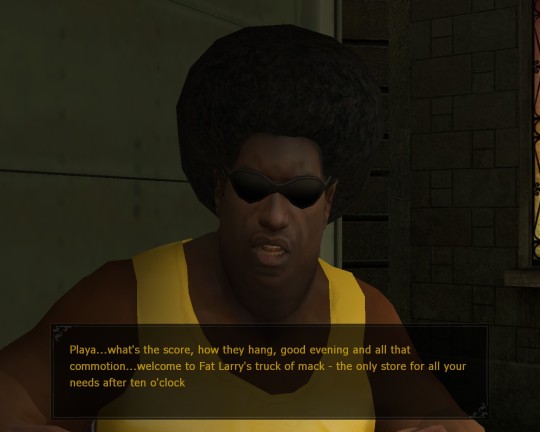
(Ah, Fat Larry. I will never forget you.)
One more major writing point I want to talk about is the game’s use of horror elements. The game as a whole can best be described as a sort of RPG with heavy leanings of horror. However, when the game decides to use these elements, they are used to interesting, if not great, effect. The first such instance takes place in a haunted hotel, which is basically a homage to The Shining (one in a looong series of classics I have yet to check out). There are no enemies to fight, but goddamn if I didn’t have my weapon drawn the entire time. The sound effects and scare timing are perfect, and while the visual effects are a bit dated, they get the job done. I especially liked the whispering, indistinct at first, but increasing in clarity as you trek through the level until it sounds like someone’s whispering directly into your open earhole. Unnerving. The second horror-type location is a venerable house, opulent and imperial. Except this one was inhabited not by festering abominations, but by regular people driven to madness by the owner of the manor, an old-school psychologist who’s lived for centuries due to his vampirism. This guy loooved his insane asylums and it shows; the level plays like a combination of a haunted house and a haunted asylum; and I was never sure if an inmate was going to stand still and mutter or if they were gonna attack me. The audio logs kept on archaic recording devices further added to the atmosphere, detailing owner’s descent into paranoia as the voices that plagued him increased in volume and number. Next, we have zombie plagues! Zombies actually appear twice in the game, and both times they’re used to convey a sense that you are surrounded on all sides, as they spawn from areas you thought were cleared out, and have a nasty habit of appearing just around corners. The first time you encounter them is in the home of a blasphemous preacher who is... over-enamoured with disease and pestilence. Context and previous experience convey the idea that these zombies were formerly people, and that this preacherman’s sickness has touched far more people than expected. The second time zombies are encountered is in the basement of a deadly-decadent family mansion, and in this instance, there’s a sense that you are right in the middle of enemy territory, except the enemy wants to moan loudly at you and grab and eat you. Whereas in the first zombie-quest, you were trying to fight your way through the hordes to a definite end, in the second zombie-quest, it feels much more like you’re trying to escape a fucked situation, even though you’re again trying to get to a definite end. The last instance of horror is one wherein, again, there are no enemies, but there are still scares aplenty. It takes place in an abandoned hospital, and while the happenings seem to be spectral, in the end, it turns out that it’s all being caused by a cannibalistic vampire, who happens to have a quest for you. The end of the hospital is gruesome, and trek there is filled with tight corridors and gory killings observed too far away to do anything about. Oh! I almost forgot to talk about body horror. Yes, there are a couple of levels that indulge in quite gruesome body horror, once in a cliffside manor, and again in a sewer system. The sounds the afflicted enemies make as they announce themselves is far more horrifying than their actual assault, and when you learn that these monstrosities were once human, your sense of revulsion will tinge with pity and additional horror.

(There are also werewolves, which are unkillable and grant the player the additional horror of being chased and hunted down. Good stuff, that.)
So the game knows how and when to use horror elements, but on the other side of its lawn of atmosphere is a gritty, seedy weed-field that pervades the entire setting. Apparently, Los Angeles is going through some shit at the time the story takes place, with gun-hustlers on every street corner, cops shooting to kill for any given offense, and sex work being the industry of choice among young white ladies with bob-cuts. Everybody’s dressed to the 90′s. And worst of all, there seems to be a massive homeless problem that hasn’t even been remotely addressed. It’s not just always night, but it’s always gloomy to boot. One half-expects the Punisher or a similar personage to pop out of the plasterwork and start waxing philosophical about the inherent degeneracy of humankind of some such rot. But make no mistake, the atmosphere thus conveyed is not an unwelcome one; indeed, the gloomy, gritty feel of the game enhances the experience and really lets you feel the oppressiveness of the “something in the air” that the other vampires go on about without giving you a mechanical indicator. You’re clued in organically that something isn’t right by the low state of the general populace and of the city itself.
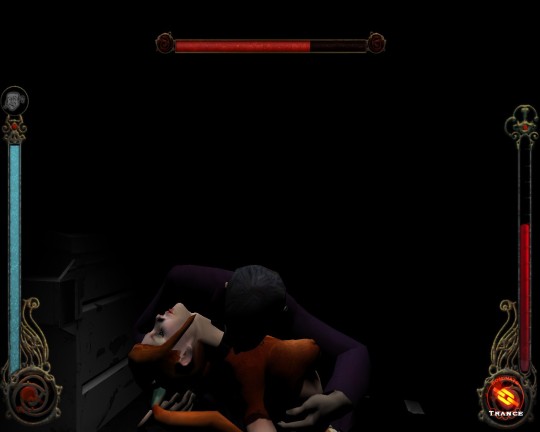
(Of course, the sex workers are there to provide the player with a way to non-suspiciously feed. I mean, it’s probably fine; I paid them after all, so it’s fine, right? Right?)
Of course, there some points about the game that may turn some people off from a sensitivities standpoint, and such concerns not without merit. First off, there’s the aforementioned ethnic and racial stereotyping, which for some people can’t be fixed even by all the characterization in the world. And it doesn’t just hit black people. Oh, you haven’t heard? Los Angeles has a Chinatown. In addition, a lot of the female NPCs, and even a female player, are clad in, by default, skimpy dress; and I’m not even talking about the sex workers. A more nuanced weirdbad thing occurs in the system by which certain victims give you more blood than others. Basically, while rats only give you a little blood and humans a lot, this makes sense. What makes less sense is that homeless people give less blood than upper class people when fed upon. Certain characters imply, or even outright state that the quality of a person’s blood is directly tied to the kind of life they’ve led. A PhD is worth more blood than a regular dude, who’s worth more than a homeless person. Attaching objective worth to a person’s standard of living is classist, if nothing else, and the implications made me uncomfortable. However, I think this comes from the source material, White Wolf’s Vampire: the Masquerade tabletop game, so I don’t think we can blame the game devs for this one specifically.
So do I like VtM:B? Yes, I should think so. Even if the gameplay’s a little janky at times, and the game world’s a bit gloomy, I liked the strength of writing and fleshed-out characters quite a lot. Will I play it again? Well, let’s just say that this is one of the few games I managed to finish in time for a review (for obvious reasons), and I already started another playthrough. For your information, I started with a Tremere, and in the second run, I’m trying out a Nosferatu.

(I should note that yes, this is exactly how all white people dance. Also note the lack of a band in the background. Yep.)
#archon reviews#review#video games#video game#vampier the masquerade bloodlines#dark fantasy#modern fantasy#vampires#rpg#vampire the masquerade
4 notes
·
View notes
Text
The Archon’s Review of Crush Crush
Crush Crush is a dating sim/clicker game/idle game made by Sad Panda Studios. You play the role of a generic male or female protagonist, as you attempt to woo a series of women. You are aided in this quest by a small green fairy. Can you maintain multiple jobs, indulge in multiple hobbies, click the mouse a whole lot, wait a long time, and ultimately win the heart of every girl? Only you can find out...

You ever need a day off? Like, you ever have something horrible happen to you on a level you could never have considered up until then? So you react by drinking heavily, losing all motivation, becoming a hermit, and finally by pushing back the due date of your next review a frankly unacceptable amount of time?
Anyway, Crush Crush is surprisingly entertaining experience. I’d call it perhaps a “poor man’s Hunie Pop", a comparison which may be more apt than I originally anticipated writing this, as CC is free-to-play. Then again, the porny bits are paid DLC on Sad Panda’s website, so I dunno.
The primary writing conceit is that the title is a punning on the word “crush”. You have crushes on all the romancable ladies, but the meet-cute for each has you “crushing” them in some way, usually by accident. For example, when you meet the first girl, you break all her bones. When you meet the gamer girl, you crush her high score, and when you meet the philosophically-minded girl in the maid outfit, you crush her mind with a hideously outdated Matrix reference. It’s a cute joke, and they do as much as they can to prevent it from getting stale.

(Oh noes! It was an accident, I swear!)
The joke also provides the framework by which progress is measured. Seeing as how you’ve just #shrecked your prospective paramour, she isn’t going to be too fond of you from the start. So, you’ll have to work hard to bring up the relationship gauge, to go all the way from “Adversary” to “Lover”.
This actually leads me to something I sorta dig about the game. Even as simplistic as the game is, it manages to present a relatively organic progression of a relationship. Except under specific circumstances (which I’ll get into later), it actually feels like it takes effort on the player’s part to progress their chosen lady’s relationship, even if that effort is mostly invested in picking the right hobbies and clicking a whole bunch.
This brings me to the mechanisms of the game. To progress your relationship, you have to level up various attributes, which requires you to pick up hobbies, which take up time slots, three apiece. You also need to make money to buy gifts, and so you need to pick up jobs, which take up varying amounts of time. This means you can only have a certain number of jobs/hobbies, and dates take both time and money, so you may need to drop a job or hobby for a hot sec. To get the gauge itself up, you have to click on the lady in question, or if you have high levels of the attribute they like, it’ll increase on its own. I guess they just stare at your amazing... tech savviness(?) and become enraptured over time.
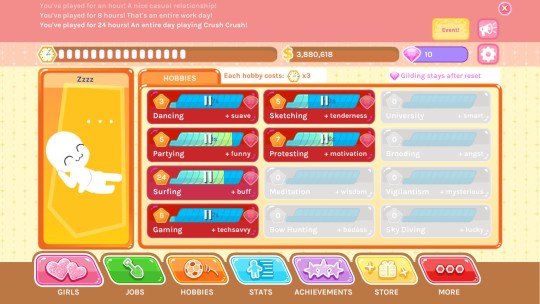
(Did you know the only way to become suave is to dance for several hours a day, every day? For eternity.)
So, I mentioned that this is also an idle game. And that is true. However, most idle games only progress while you have them booted up. So you may imagine my surprise when I booted Crush Crush back up after a night’s sleep, to find that I’d accidentally progressed my relationship with two girls, unlocked a new lady, ascended to very heights of strength, compassion, and wisdom, become a millionaire, and cured cancer. So, if you like being in control of your progress, this game may not be for you. I can’t wait to find out how amazing I’ve accidentally become after a few weeks off the game...
Also, it takes a page from Cookie Clicker. Certain milstones add a point value (a nebulous value at that) to a multiplier. You may then reset your progress, and on your next run, all the automatic processes will progress that much faster. This becomes almost necessary later on in the game, when some ladies have intense requirements to progress their relationship gauges.
One last thing I kinda really dig is that there’s actually a wide variety of potential paramours, each with their own cute and fun personalities. For example, you may date Joey Wheeler, a “g4m3r gur1″, that one artist you knew in college, Slenderman’s sister, or even a bear. Yes, a literal bear. Some of them even have some pretty cute/sardonic jokes. For example, the gamer girl requires, at one point, 1337 dollars in the bank. On the flipside, the cat lady is homeless. Why? She’s a freelance artist.
What is there to recommend, about Crush Crush? Well, the panoply of potential paramours consist of cute, but surprisingly relatable and engaging characters, especially for a free clicker/idle game. Perhaps it the low bar I had set for this game, but I found myself genuinely entranced by the characters and the progress bars and way your avatar gets more attractive the more progress you make. Also! You can be a lady, meaning that each and every character, with the exception of a male protag, is at least bisexual. So, if you’re in the market for a surprisingly entertaining time waster, play CC. I’ll probably come back to it in about a year when I’ve become the goddamn demiurge by accident.

(Did you know that a bouquet of flowers costs $2,147,787? Cause I sure didn’t.)
11 notes
·
View notes
Text
The Archon’s Review of Pharaoh + Cleopatra
Pharaoh is a city-building game set in ancient Egypt, created by Impressions Games and published by Activision. You play each successive generation of a noble family as they guide and build up Egypt from its archaic pre-dynastic era all the way to its height in the New Kingdom. The Cleopatra expansion extends the timeline up to the battle between Antony and Cleopatra, and Octavian, the second ever Caesar. Build great monuments, design big ol’ cities, and defend Egypt from her enemies. Succeed, and your name will be remembered for generations. Fail, and pharaoh may see fit to send his armies against your fair city...
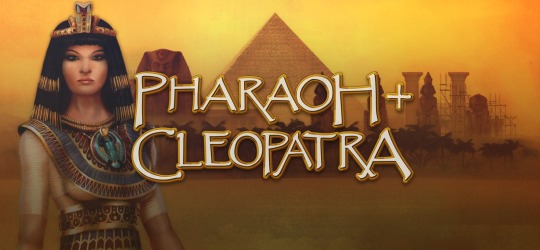
So, full disclosure, while i try not to review games that I have extensive prior experience with, in this case, I will admit that I did play quite a bit of this game when I was quite young, like, around 6 years old. Incidentally, I didn’t realize that the negative sign in front of my money stockpile meant that I was in debt, and when that number seemed to go up with every building I put down, I was delighted. At least until Pharaoh sent his armies against my fair city.
The central conceit of the game is city management. Each mission, you have a set of milestones to hit, such as population size, the construction of a certain monument, or achieving a certain culture score. To achieve these objectives, you have to build places for immigrants to live, places for them to work, entertainment; you have to provide food, water, and medical care, and even defend them against Egypt’s many enemies.
You are granted several resources in aid of this task. First, you start with a healthy infusion of cash, which you will supplement with taxation, trade, or, if you’re very fortunate, gold mines. You also have a set of advisors who can tell you everything from the attitude of the Pharaoh towards you, the attitude of the gods towards you, and the attitude of your citizens toward you. You can also right click on any of your citizens to find out how they feel about your city. If there’s a problem, they will be quite vocal about it.
Speaking of your citizens, they operate on what I believe is called a “walker” system”. Basically, as long as a service, such as an apothecary’s office or a bazaar, is fully staffed, it will produce a “walker” specific to that building, who then walks along the roads of your city, providing their service to any houses it comes across. For example, a constable or magistrate will reduce the crime risk of any neighborhoods they pass by, and tax collectors will tax any houses they pass by before returning to the tax office to deposit the money. Services staff themselves by sending out a “Citizen” walker once you have houses that people live in. When they pass by a house with unemployed people inside, the service will use as many as it can to staff itself. It takes a lot of pressure that would otherwise be on the player to make certain their city is effectively up and running. Although, it does attract some derision from people who would rather take a more active role in building their settlement. “You just kinda watch your city do its thing,” is the common complaint.
Resource management is actually a critical part of this game. Many objectives require bigger houses, which require increasingly higher levels of luxuriousness. You’ll start by providing your people basic necessities, and eventually end up furnishing them with the finest in entertainment and beer. Much of the challenge comes in refining the natural resources you harvest into finished products (assuming the raw materiel is available and you aren’t forced to trade for the finished product itself), and a single disaster in the raw good-to-refinement-to-storage yard-to-bazaar-to-citizens pipeline, such as an inopportune fire or building collapse, can seriously disrupt the entirety of your city’s progress. What can be especially galling about this is when the same disaster keeps happening even when you have, like, 15 copies of the relevant buildings to prevent it spread around the city. The worst disaster that happened to me was when my city was routinely depopulated by plagues even though I had 11 physician’s offices spread all around the city. Like, it got so bad I couldn’t even keep the physician’s offices themselves fully staffed. When things like this happen, your main option is to wait for the RNG to swing back in your favor, and then you can get back to city-building.
I did mention defending your city from Egypt’s enemies, and there is combat here and there. It’s not the main focus, and it suffers for it. Soldiers in opposing armies will graciously fight one-on-one, literally lining up in some cases. This makes archers a lot stronger than they first appear, because they’ll fire all at once, apparently lacking the chivalry of their melee cousins. Hilariously, constables will fight enemies for you, but will die almost immediately. I do appreciate their dedication to the law, but I worry that their cavalier disregard for their own lives is inflating the disconsolate war-widows market somewhat.
One of the more fun aspects of the game is the monument building. You’ll construct everything from the Sphinx, to ancient mastabas, to the iconic Pyramids. What’s most entertaining about it is that while most buildings go up instantly, as soon as you’ve paid for them, monuments require great expenditures of resources such as bricks and burial goods, and grandiose amounts of manpower from staffed work camps. You’ll get to see your monument go up over the course of the game, and in the end it feels as though you’ve achieved something truly grand.
فى الختام،, I actually liked Pharaoh + Cleopatra quite a bit. I know it seems like I ragged on it a lot, but really anything I didn’t explicitly critique, I really liked! The game is simple to pick up, has a competent learning curve, and building up a city from nothing gives a great feeling of accomplishment. I’ll probably come back around to this one, and also to Caesar III, which is basically this game but in Rome. Or maybe vice versa? I’m not sure, but essentially, a review of Pharaoh game could probably double as a review of Caesar III. This isn’t necessarily a criticism of either game... I’ll just say that Impressions got a lot of use out of this engine.
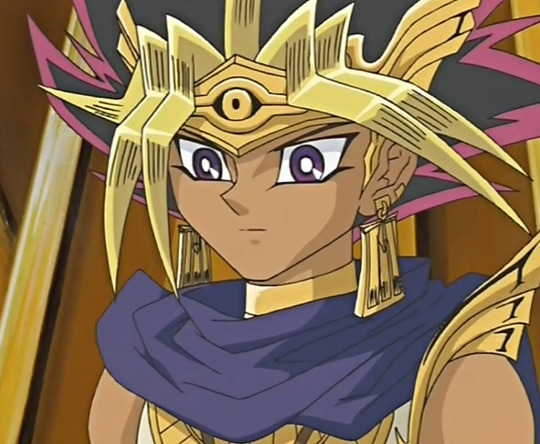
(Not to be confused with Pharaoh + Atem, a Google search which would likely net you the above image.)
1 note
·
View note
Text
The Archon’s Review of Powerwolf
Hey guys, I think I’m going to review music now. Like, I’ve gotten really bored of video games lately, and music looks fun! So we’re doin that now, okay?
Powerwolf is a German power metal band formed in 2003 (jeez I feel old) by Charles and Matthew Greywolf, not to be confused with Greyjoy, which is the viking house in Game o’ Thrones, and also not with Greybeards, who are the old dudes in Skyrims. Powerwolf deals in dark themes, such as Romanian myths of vampires and werewolves, the Roman Catholic church, and masturbation. They also utilize tools such as semi-priestly vestments, corpse paint, and long hair to present an appearance of being the grim arbiters of an unforgiving, belligerent, but otherwise “rad af” religion. Their most recent album was Blessed and Possessed in 2015, which also happens to be my favorite.

Oftentimes, a good piece of media asks a question of its audience, and Powerwolf is no different. The question being asked of us here is, “What if the Roman Catholic Church was run by a shadowy cabal of vampires and werewolves?” The answer is apparently that there’d be a lot more crusading, albeit only at night, and that the “blood of Christ” bits would be taken to a frighteningly literal degree.
Powerwolf makes liberal use of heavy drums and what I’m hesitantly calling “guitar accents” because they don’t always form the center of the music nearly as much as the drums, but they mostly come out in solos or to help along the drums; of course, this isn’t the case on all tracks, and in, for example, “Christ and Combat”, the strings feature quite heavily. All the same, Powerwolf is a very drum-dependent band. Not that that’s a problem, I actually like the drums! They make the tracks easy to tap along with.
In addition, they use a heaping helping of Eastern European languages and Latin, often chanted. This is especially evident in the tracks “Armata Strigoi” and “Sanctus Dominus” respectively. This is in aid of the whole “Dark Catholocism” theme they’ve got going on.
Many of Powerwolf’s tracks come in one of two varieties. These are, “Array thyselves against the heretic and fight in the name of God/Satan! Deus/Diabolus vult!” or “The Catholic Church is infested to the gunwholes with vampires and werewolves and they cannot be stopped!” Both varieties are perfectly listenable, and they are bound together thematically, again, by the “Dark Catholocism” thing they’re doing.
However, if the Youtube comments on some of the “Crusader” songs are to be considered, there is an element to Powewolf’s fanbase that I find rather troubling. That is, there are some people who listen to their songs and get jacked up on the idea of a... uh, let’s see, 10th crusade, and that can get kind of uncomfortable if you encounter that side of the fanbase. Now, to be clear, I haven’t found any evidence to suggest that the band actively supports or encourages such people, but it can still be discomfiting all the same.
I really like Powerwolf! Their tracks are heavy, but intelligible, and catchy without being kitchy. It’s the perfect thing to listen to while you’re playing a video game or cleaning your room; one moment you’re listening to a rad drum-assisted guitar solo and listening to a burly man in paint sing about Catholic werewolves, and then suddenly you’re finished with your task, and you have to take a quick breath because you’ve been mouthing along to the words the entire time without realizing it.
One last thing; the band occasionally sees fit to do covers, and although many people seem to like these, I personally think the lead singer’s voice isn’t suited to the songs they choose, and there always seems to be something... hollow about the music itself whenever they do covers. I suppose it’s because there doesn’t seem to be any pauses in a normal Powerwolf track, but in their covers, they play those pauses? In any event, my advice to listeners is to stick to the non-covers.
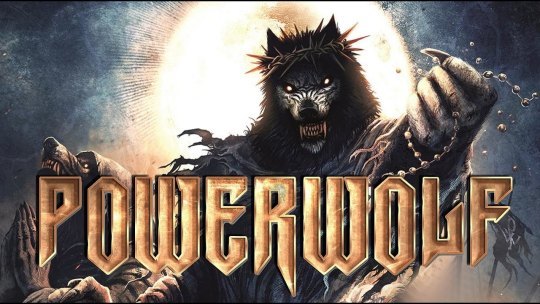
(Forgive me father, but please don’t eat me.)
2 notes
·
View notes
Text
The Archon’s Opinion: A Case For Killing Cthulhu
A great while back, the folks at Extra Credits released a video called “ Why Games Do Cthulhu Wrong - The Problem with Horror Games“. It’s not a bad video, and they make a decent case for video games in general misusing the Cthulhu Mythos and its creatures and what those creatures represent. The main thrust of the argument is that once you’re able to kill Cthulhu or the monstrosities of the Mythos, they lose all impact. While that’s a fair tack to take, the video sat disquietly in the recesses of my think pan, and I think I’ve finally figured out why. I’m going to discuss killing Cthulhu correctly, and why it seems like so many games get it wrong.
Splash image from GregStevens from Deviantart.

First, we should begin at why one might say that you shouldn’t be able to kill the monsters of the mythos. Cthulhu et al represent, in aggregate, a cosmic force on a scale that humanity is utterly incapable of comprehending, let alone facing in open combat. Cthulhu, Yog-Sothoth, Shub-Niggurath, Hastur, Nyarlathotep; these names all represent forces so horrific, so beyond our normal paradigm that the human mind merely balks, deciding that insanity is safer than genuinely attempting to understand these cosmic, near-infinitely powerful beings. They’re all representations in flesh and ichor the insignificance of humanity in the cosmic scale.
However, that nigh-omnipotence that these beings possess is part of why it may be so fun, and so effective, to allow a protagonist to kill them; if it’s done well, that is.
You see, in many works, there is a sense of catharsis from resisting a force greater than oneself, from saying “Fuck you!” to the divine, the infernal, or merely the incredibly powerful. There is also something incredibly self-affirming about defeating a being ostensibly more powerful than oneself, about assuring the universe that you matter. In this way, a game that allows you “kill Cthulhu” subverts the Cthulhu mythos’ primary conceit, and in so doing, can potentially grant the player a great sense of accomplishment and self-worth. After all, if you were confronted with Cthulhu, wouldn’t you want to have the willpower to tell him to fuck off?
Of course, this has to be done with skill; often, games merely have a Cthuloid monster or two appear as just a particularly fucked-up-looking enemy type. A particularly irksome example of this behavior is found in the fantasy 4x game, Age of Wonders 3, in which there is literally a unit referred to as an “Eldritch Abomination”. It’s got plenty of resistances, and power extraordinary, but when I successfully kill one, I don’t feel as though I’ve struck a blow against the tyranny of ineffable, inconceivable forces, I merely feel as though I’ve killed yet another enemy, one of many.

(Doesn’t even look all that Cthuloid, honestly.)
There are several ways to make killing Cthulhu satisfying and fun, while keeping true to the overall feeling of the mythos. While I haven’t played the Dark Souls/Bloodborne series, my preliminary research indicates that those games allow the player to kill all manner of monstrosity while maintaining an air of oppression and a sense of human insignificance. Nonetheless, the player in the Souls games does fight through their eldritch opponents to accomplish their task, and so even if the air’s oppressive and your individual actions seemingly insignificant, you still impact the world, as opposed to Lovecraft’s protagonists, who usually end up insane, arrested, or in a psych ward.
Now, I have played a game that captures the essence of Cthulhu pretty well while also allowing the player to kill mythos monsters. However, this game also adds a lot of Edgar Allen Poe and Victorian-era horror to the mix. I am talking about, Darkest Dungeon. This game is actually somewhat ingenious in a few ways. First off, it isn’t actually you going into the titular dungeon. The player hires adventurers to go into the dungeon for them. This way, the game doesn’t have to try and simulate the effects of madness on the player themselves, but allows the player to witness those effects on others. It’s like, you don’t have a sanity meter, but your hired help does. Also, the game doesn’t really get into the Cthulhu-type stuff until near the end. The fish-monsters are a pretty clear reference to The Shadow over Innsmouth but other than them, the enemies take on a more Gothic style than anything else. This allows the mythos elements to be built up to a greater extent, and while the ending has you succeed in slaying the horror in depths of the dungeon; thus allowing a player to achieve a sense of victory and triumph, should the player start a new game, it becomes implied that the events of the game keep happening over and over again, the past repeating as the previous owner refuses to learn their lesson. This, should it be discovered by a player serves to preserve the Lovecraftian theme of human insignificance in the face of forces beyond human control or comprehension.
Now, I hear you ask, “That stuff’s all sad catharsis, or sadtharsis, if you will. I thought we would be hearing about fucking Cthulhu?” Well, my straw-reader, first off, I said that we would be telling Cthulhu to fuck off, not fucking him (an experience I imagine to be most unpleasant, but ya never know). And second off, allow me to ask you a question of my own: have you ever played Bayonetta? Because the primary antagonist of the first Bayonetta game, while being distinctly un-betentacled, does represent much of what Cthulhu also represents. They’re a creator deity not in our image; they have powers incredible, almost incomprehensible to mortals. Their servants are all beings from another dimension, and both this antagonist and their servants have a subtle wrongness about them, which is only exacerbated by the insistence that they are divine, angelic beings. The antagonist I am referring to is Jubileus, and at the end of the game, you get to throw them into the fucking sun, and then blow up all the parts of them remaining in space before they hit the earth. It’s nothing short of amazing. I mentioned a subtle wrongness about Jubileus and their servants, the angels; and to the game’s credit, it preserves that feeling the entire way through. Never once when I played through Bayonetta did I ever feel as though these were normal enemies such as I would encounter in any game, despite my slaughtering them by the score. Jubileus being similarly wrong, gave me immense spiteful satisfaction when I slew them. Throwing them into the sun was the ultimate in human affirmation against the dubiously divine.
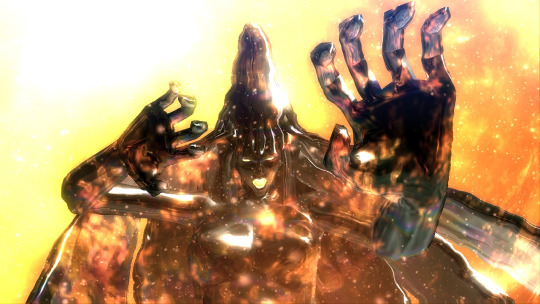
(Hah! That’ll teach you to create the universe!)
Generally speaking, the best way to allow a player to glean satisfaction from slaying Cthulhu is to do your best to retain the feeling, the perverse grandeur the mythos contains. If you can preserve the impact of the mythos while allowing it to be killed, you can open up a lot of possibility space for your game. Will you do the Dark Souls thing, using body horror-ed monsters as a symptom of a decaying, uncaring universe? Will you go the Darkest Dungeon route, building up to the mythos, allowing the player to kill it, and then allowing the player to unwittingly pull the rug out from under themselves? Or will you go full Bayonetta, a celebration of godslaying in the name of affirmation and quite possibly spite? Or will you do some fourth, un-discussed thing? The possibilities, like the form of Azathoth the Blind Idiot God, are vast, and like the Deep Ones, they are many!

(Or you can do this silly thing! Omnomnom, Cthulhu loves to eat boats, apparently.)
#archon's opinion#article#op-ed#cthulhu#lovecraft#cthulhu mythos#bayonetta#darkest dungeon#dark souls
0 notes
Text
The Archon’s Review of Kingdoms of Amalur: Reckoning
Kingdoms of Amalur: Reckoning is a fantasy role-playing game developed by Big Huge Games and published by Electronic Arts. In the fantasy realm of Amalur, Fate has dictated the comings and goings of all things. Particularly sensitive to the workings of Fate are the immortal Fae, whom are divided into the Summer Court and the Winter Court. However, tragedy strikes when a rebellious Winter Fae named Gadflow decides that the current Winter King isn’t doing enough murder, and that he should be king instead. After killing the Winter King and usurping his throne, Gadflow and his followers, the Tuatha Deohn, go to war against the mortal races of Elf, Gnome, and Human. The mortals seem doomed, as while the Tuatha can be killed, they reincarnate quite quickly and return to fight, whereas the mortals die when they are killed. To circumvent this disadvantage, a Gnome by the name of Fomorous Hughes creates the Well of Souls, a device meant to resurrect the dead. You are its first apparent success, and in the process of reviving, you become unbound from Fate, and basically ruin it for everyone. Now, you are the last hope for mortal-kind to defeat the villainous Gadflow and his Tuatha followers, restoring balance to the Fae Courts and preserving the realm of Amalur.
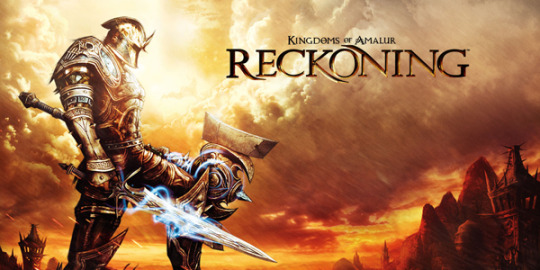
I first heard of Kingdoms of Amalur back in the mid-2000′s, just around when I was playing Oblivion obsessively. It was contemporary with another third-person fantasy thingie, Two Worlds, which the GameStop employee recommended against, before trying to shill for GameInformer. I suppose my point here is that I picked up KoA:R because I was curious to see what I had missed all those years ago. And yes, I am aware of the controversy surrounding the game’s creation and the dismantling of Big Huge Games, but I must confess to not being too familiar with the happenings.
The first thing one may notice in this game is the graphics. They’re actually pretty damn good, with beautiful vistas and vibrant landscapes. The characters are surprisingly expressive, even if that expressiveness does result in some humorous facial expressions. The character models are a little funny though; all the men, at least, have what I like to call “Ground Beef Body”. I ended up naming my character “Flaskkott Djur”, or “Pork Animal” in Swedish because he immediately reminded me of a hunk of ground beef (I got the word “Flaskkott” confused with the word “Nottkott” which is “Beef”. There’s your Swedish lesson for the day).

(Just look at that chin! And he’s got the neck of an ox to boot!)
Speaking of vistas, the diversity of environments is greater than I might have expected; although, get ready to see plenty of magical forests. There are, however, plenty of deserts, beaches, swamps, and arid landscapes to explore, all with plenty of monsters to kill and things to loot. All the environments are quite pretty and vibrant to behold and great emphasis has been placed on making each area feel like its own self-contained region. Even the magical forests feel different enough from one-another that you’re not likely to get lost.

(Upward shot of one of the game’s major cities. Go all the way south, along a beach and across a desert and through a forest, and you’ll find a Greco-Roman city ruled by Gnomes, as opposed to this necropolis-looking thing.)
Character creation is interesting. You only have two choices at the start; race and deity to worship. Funnily enough, you can choose to be an atheist, and it may be the best choice in my opinion, not because I’m some trilby-wearing “Dark Enlightenment” nutter, but because being an atheist gives you a permanent +1% experience point boost, and I’m always a slut for levelling up. All the other deities give you different boosts, and each of the four playable races gives you certain bonuses to non-combat skills.
When I say that you only have two choices at the start, I was leading up to something. See, KoA:R sort of has you create your character throughout the entire game. Every time you level up, you get a point for non-combat skills and for combat abilities. You could easily make the case that all RPG’s do something similar, having the player build up their character over the course of the game, but the difference is that KoA:R basically gives you nothing to begin with, save for a few points in all the beginning combat skills, plus a few points in non-combat skills dependent upon your chose race. Most other RPG’s would at least give you a bit more than that, if only to establish a direction. KoA:R is unique in that building your character is a persistent, fluid process, which keeps it engaging; in addition, the ability to refund all your points for a small fee allows you to go back and try a different build should you get curious/ fed-up.
One side-note I’d like to make mention of: If you’re the sort of person who gives a shit about difficulty curve, don’t buy the “Weapons and Armor Bundle” DLC. As the name would suggest, it creates a chest in the first town filled with weapons and armors for you to grab and use at your leisure. And while you’ll get/craft better equipment in time, it’s still better than the equipment you would otherwise have at the time, and it throws the balance off for a bit.
Speaking of crafting, the game actually has a pretty rad crafting system which allows you to create equipment, potions, and socketable gems. And frankly, once you put enough points into the requisite skills, you can craft some frankly ridiculous things. After a while, I was salvaging nearly all my equipment for the spare parts, rather than selling it. Gold wasn’t much of an issue anyway, and I wanted to see if I could craft an even more effective murder tool.
If it seems like I’ve been avoiding the topic of combat for a while, it’s because I’ve been avoiding the topic of combat for a while. Honestly, I think it’s one of the weaker elements. It’s slow and cumbersome, and it’s completely possible to be hit for a full combo because you couldn’t get your fucking shield up in time because you were already swinging at a different enemy. Whenever I swung my sword, I was committed for roughly the next half-hour. Also, for those of you more used to Dark Souls styled dodge-rolling, I should warn you that the dodge-roll in this game does not seem to have any invincibility frames; it just zips in a direction real quick is all.
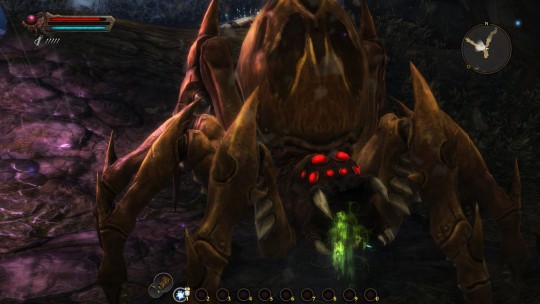
(Spiders rather quickly became my arch-nemeses. They always came in groups, attacked somewhat unpredictably, and where often harder to kill than might be expected.)
To be fair, once you level up a bit and develop your own tactics, combat becomes easier. Learning your enemies’ attack patterns and learning abilities that stagger them, or prevent you from being staggered will help immensely.
If the plot synopsis up there seemed kind of involved and a little faffy, it’s because that’s how the game is. Ostensibly, the whole thing is based on old Irish and Scottish myths about the fae, and while the influence is clearly there, and it’s clear that the devs at least did a modicum of research on the mythologies they use. I like the idea of fighting Fate, the rapacious bastard. Although, there’s a bit where it’s implied that you’re appearance (remember, your character exists outside the web of Fate) was itself predicted by Fate. As others have pointed out, that point is kind of mad, but it’s not as big a deal as it sounds, and there’s evidence to suggest that perhaps Fate has simply rewritten itself to fit you in.
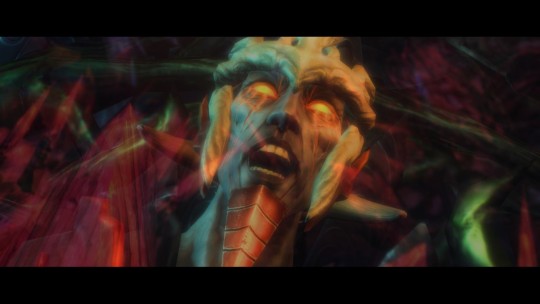
(The antagonist either screaming in madness or receiving amazing head. I’ll let you decide.)
Now, I have a bit of a confession to make. I spent almost my entire time playing this on sidequests. Much work has been done to ensure that the sidequest chains are engaging, from helping the resident mercenary guild fight an invading demon lord and his army of elven followers, to saving a small village from a rogue Fae and her spider minions. I had a lot of fun on all the sidequests; I almost forgot about the critical path. By the time I got back, I was massively overlevelled and had a set of powerful equipment to back me up.
Here’s a weird thing apropos of nothing: while the human ladies are dressed normally (boob-plates notwithstanding), the elven ladies are almost always in some kind of revealing top, often a deep V-neck. I have no idea why this is; there’s no lore reason for it. Maybe Big Huge consisted entirely of elf-misogynists? It’s bizarre is all.

(She’s just dressed like this. No idea why, especially when a normal human wearing leather armor has it look like regular leather armor.)
Now, some people have compared this game to Skyrim; certain reviewers even calling it “Baby’s first Skyrim“ I don’t necessarily think the comparison is a fair one. Whereas Skyrim is very much a standard fantasy RPG in the vein of its forebears, KoA leans more heavily on semi-frenetic combat action, even bumping up against the (admittedly nebulous) action-adventure genre in the subway car. Crafting is different as well. Whereas Skyrim has you stock up on ores and ingots to craft with, this game has you salvaging your old weapons to find screws and grips and rivets, which gives the crafting a different feel, even if they are functionally very similar. While Skyrim is admittedly a more detailed, immersive experience (glitches notwithstanding), KoA is about as complicated as it needs to be. It gets in all the features it needs to be a pretty good game in its runtime.
And Kingdoms of Amalur: Reckoning is a pretty good game. Levelling up is more addictive than it is in most RPG’s, and great pains have been taken to make sure that each quest is fun and interesting, not just the main questline. Despite the reputation it’s accrued as a cut-rate Skyrim or “That one game what got a bunch of people in trouble and now it’s owned by Rhode Island,” I’d recommend it to anyone who likes somewhat complex fantasy worlds and/or anyone who likes their RPG’s a little bit on the actiony side. I may come back to it. After all, I’m more than half-way to the level cap and I’m not even close to the end of the main quest.
All in all, it’s a damn fine game. Would love to complete it some time.

(A back shot of a male character. I told you these people are made of ground beef.)
4 notes
·
View notes
Text
The Archon’s Actual Review of Doki Doki Literature Club
Right then.
Doki Doki Literature Club is a horror game created by indie developers Team Salvato, cleverly disguised as a dating simulator. You are a human playing a dating simulator when it quickly and unexpectedly becomes a horror game.
Just in case I haven’t been clear: there will be spoilers. This will be a recounting of my experience playing this game, as best as I can remember it. Trigger warnings for suicide, for gore, for violence, and for depression.

I must have done something horrible for my friend to convince me to play this game by way of vengeance. Of course I’d heard of DDLC by reputation; it was that one game disguised as a cute dating simulator. Nonetheless, I was relatively unspoiled, and while I expected a tonal shift, I was all the same unprepared for the degree and the abruptness at which that shift would come.
But perhaps I get ahead of myself. I booted up the game and was immediately charmed by the bouncy music and charming visuals. I named my character after myself, which I realized soon after was a horrible mistake. One of a couple. The opening scenes played themselves out; Sayori, the child-hood friend, rushed up to meet me on the way to school, convinced me to join the literature club, and from there it was off to the races.
Again, I was acutely aware that something was very wrong, or rather, something was about to be very wrong. I was checking for foreshadowing in every dialogue box, and checking in with my friend constantly (of course, he didn’t want to spoil me, but his presence in the Steam chat helped with my rampant anxieties nonetheless). I met the other girls, Natsuki, the tsundere, Yuri, the “shrinking violet”, and Monika, who is Monika. I was immediately drawn to Yuri, enticed by her quiet, bookish charms and her violet color scheme, and so I spent as much time with her as I could, and dedicated my poems to her.
Then, when it was revealed to me that Sayori had depression, my heart went out to her. Not that I gave her my heart in the way that Yuri had it, but that I related with Sayori on a personal level, as a knew a touch of what she was going through. I wanted to see if we could remain good friends throughout the game, if I could help her with her depression.
But I knew my tropes. I knew, in my heart of hearts, where this was going. But I looked closely for a decision that would allow me to get Sayori the help she so desperately needed, while also looking for opportunities to advance my relationship with Yuri. I hoped against hope that I could do something to salvage this situation.
I liked that Yuri collected knives. Note the past tense.
When Sayori confessed her love to me, it was almost out of the blue. I was tempted to accept it despite myself. But I knew that throwing myself into a relationship with someone solely to assuage them couldn’t be the right choice. It tasted of ash; in much the same way soon-to-be divorced parents make the decision to stay together “for the kids”, despite their unhappiness. So, I told her that I wanted to stay friends.
But as I read my character’s text box telling Sayori that he didn’t want to be with her romantically, but that she should trust in him, that he would get their friendship back on track, that he would take control, my lips pursed into a frown and my heart began to beat hard as a ship’s drum. That wasn’t what I wanted to say, I thought to myself. I suppose I should have keyed into the fact that my decisions vis a vis the game no longer held any significance, that my course was set, and nothing save for the altering of the game’s internal reality would change it.
Before she confessed, Sayori mentioned that Monika gave her some advice. This would help inform some later decisions.
When the moment came, the music stopped, and I knew what had happened. I’m not certain as to what I was expecting, but I was all the same horrified. The game glitched itself out as my heart thudded like a fist pounding the walls of a prison cell. Sayori had ended her life via hanging, and as my character attempted clumsily to sort through their emotions, I wondered, mortified, how I would continue to go through this damned world I had created. It turns out that this would not the concern I thought it would be.
The game booted me to the main menu, except that it was corrupted, not in a physical, gooey, evil kind of way, but very deliberately in a glitchy kind of way. This would more-or-less be the norm for the rest of the game.
The “New Game” button was now merely a jumble of meaningless gibberish. I assumed that this was a sign that the next leg of the journey was afoot, and so I selected it. it never even occurred to me to try to reload a saved game until a while later.
Of course, it tried to get me through the opening sequence again, but Sayori was not merely dead in one reality, but all of them, it seemed. Where her sprite should have been was a mishmash of graphical artifacts and jumbled code. And then there was a flash of light, and she was completely gone. It was Monika who invited me to the club this time around.
It was at this point that I took a short hiatus from the game; worked on other things, played some Skyrim. I deliberated on what I should do. My assumption was that it would be whomever I decided to pursue that would get written off. I assumed Monika would want to obliterate the people who meant the most to my character. I was perhaps a quarter correct in these assumptions. But then it occurred to me that it was not Yuri who was taken, but Sayori, someone I hadn’t pursued. So I thought, to protect the person I cared for most in this game, I had to pursue them specifically and without wavering. I was wholly incorrect in this assumption. My friend was no help, of course.
So I went through the first poetry minigame, Sayori’s favorite words bringing about eerie errors. Yuri seemed quite pleased with my selections, while Natsuki was entirely dismissive; each had acted as I expected. But then Monika said something, (precisely what it was escapes me) and it gave me pause. It made me consider that Monika was more self-aware than I gave her credit for, and it characterized her in my mind as a malevolent petty god, which I wished only to rebel against. I would soon see the error of my thoughts.
As the game went on, and the interface and characters continued to degenerate into more and more horrible corruptions, Yuri’s behaviors became more and more erratic, and Monika’s warnings more explicit. Yuri kept complaining of her heart beating excessively and her text boxes kept being replaced by... out-of-character dialogue. Her poems became more abstract, and twice she had revealed her desire to mutilate herself, albeit inadvertently (Monika had warned me about this too).
At first, I took all this in stride. In fact, it dawned on me that some of the reasons for the characters’ actions may be because of Sayori’s absence. In the first act, she provided a moderating influence, but without it, Yuri’s more abnormal behaviors were exacerbated, and her arguments with Natsuki became more violent. I was half-right in that Yuri’s behaviors had become exacerbated, but I was incorrect as to the cause.
I seemed to realize that Monika was not the reality-warping monster that I assumed her to be; although she was self-aware, making what I knew to be attempts at contacting me directly, and warning me that I should get away from Yuri while I could. But it was too late by the time I finally heeded her warnings. I wrote a poem specifically for Natsuki, but she didn’t even read it, while Yuri took it without hesitation. She then forced Monika and Natsuki out of the room. Monika left with a smug “Don’t say I didn’t warn you.”
By this point, I had realized that the Yuri I had dedicated myself to originally was not the wide-eyed emotions-berserker before me. I realized what I should have at the start of the second act, when everything began to go to Hell. I realized that I would have to reject Yuri’s confession.
And so I did.
I expected her to come after me. I knew she had to have a knife or other bladed weapon on her, and so I assumed she would slay my character with it. I really should have stopped making assumptions. She laughed and laughed and stabbed and stabbed herself. It was visceral and brutal, and there was nothing I could have done. I felt like all the individual actions I had taken up to that point; rejecting Sayori, not trusting Monika, rejecting Yuri, were necessary and justified, but lead to a horrid end anyway.
For three in-game days I was forced to watch Yuri’s corpse putrefy as the blood on her knife and on the floor and on her cadaver browned and dried. There was a constant text box streaming with gibberish, as was the game’s want. I waited and waded through it.
Monika and Natsuki returned on Monday, in game. Natsuki was horrified and went off-screen to vomit. Monika mentioned that she was unaware that the script was so broken, and it all clicked. She erased everything but her. It was, as the game was fond of telling me, “Just Monika”.
I was now fully aware and keyed into the nature of Monika’s abilities. She had gone into the game’s very files on my very PC and deleted the character files for the other three girls. She assumed that since she was the only one left, I would have to love her as she loved me. However, she had given me something this game had robbed from me until now: power. I now knew that I could do to her what she had done to the others.
I deliberated on this. On the one hand, I wasn’t sure it was fair to erase her from existence entirely, even as she had done for three others. Those were automatons, however, and so their demise was perhaps not a crime, per se. However, their deaths as witnessed were no less traumatizing were they mere adding machines or real people. On the other hand, her meddling was the direct cause of everything horrid about the game. She expanded on, exacerbated and intensified the worst aspects of the other characters, leading them to evil, bloody ends that I could not abide. After some consideration, I came to the conclusion that I had to do it. I had to end Monika, if for no other reason than that the game had to continue into its next phase.

(Monika’s Final Death, or so I thought.)
She was, of course, more powerful than that, and in what I thought were her final moments, she restored, by way of apology, the other three girls, and the game itself.
I was exultant! Finally, I had waded through the horror, and now, I would reap the reward, a world without the horrors I had previously witnessed.
Everyone seemed so healthy at first, psychologically.
Alas, it was not to be. For without a true Monika, Sayori my Monika would be. As Sayori began to unravel the world, Monika stepped back from oblivion itself one last time to erase her, to erase the game entirely. She played me a song over the credits. It was the sweetest thing the game had to offer. And then the game was over. Forever. Or at least until I reinstalled it.
Doki Doki Literature Club is a good game. A great game even. And yet it may be the first game that I unequivocally cannot recommend. Let me be clear, as a game, it is great. The plot is rock solid. The graphics and what’s been done with them, top-notch. Characters were interesting and horrifying in their own unique ways.
But Doki Doki Literature Club confused me as a played it, and left me an empty husk after the fact. There was none of the catharsis that comes from a normal horror experience, just the emptiness that comes with a great deal of effort and emotional input gone to waste, and the pit in one’s stomach that comes when they know they’ve made a series of horrible choices in good faith. Talking to people about my experience didn’t help. I cannot recommend this game, not because it’s a bad game, but because it left me devoid.
Team Salvato, if you are reading this, do not take this as criticism of your work. Do not assume you could have done better or that I think this was poorly done. If my assumption is correct that you wished to create an effective and frankly draining horror experience, you have verily succeeded. You did good. Pity it did me bad.
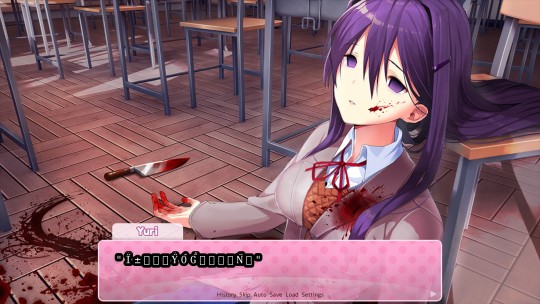
(Yuri was always my favorite...)
#archon reviews#review#horror#video games#video game#doki doki literature club#ddlc#spoilers#tw: suicide#tw: violence#tw: gore#existential terror#tw: depression
0 notes
Text
The Archon’s Spoiler-Free Review of Doki Doki Literature Club
Oh boy. Here we go.
Doki Doki Literature Club is a dating simulator created by indie developers Team Salvato. You are a high school student who doesn’t really do much of anything. Your best friend, Sayori, urges you to join a club this year, so you acquiesce, joining the school’s literature club in exchange for delicious cupcakes. When you get there, you find several cute girls, and now you must try win their hearts through the magic of poetry.
This is the spoiler-free review. This will deal, as best as it can, with the mechanics, aesthetics, and degree of impact the game had on me. You likely will have already heard of this game, and what it’s about, but in case you haven’t and you don’t mind being spoiled, the recounting of my experience of the game will be posted sometime tomorrow, probably. I apologize for any vagueness, or if this review is short; I’m just trying not to spoil. Also, there won’t be any screenshots.

I picked this game up on the recommendation of a friend, who had played it previously and was extremely keen to see me play it as well. I suppose I can say his recommendation worked. I played the game.
The music is adorable and bouncy, and it fits the pastel color scheme of the menu and some of the scenes. The piano is delightful, with a upbeat tune.
The art style is both cute and pretty, and well-defined. The characters are easily identifiable, their personalities coming across upon immediate sight.Their faces are extremely expressive, and I never felt like I didn’t know how they were feeling.
The poetry-writing minigame is fun and novel, and I was able to determine which words would best lead me to my objective just by talking to the members of the club. Great fun was had in trying to figure out what the actual poem I was writing was actually about, and stringing together the words I’d picked to form a title for my poem provided great amusement.
The plot was effective.
The characters themselves are usually relatable and interesting.
The game is rather short, but it is free, and I’d recommend it’s art style and the effectiveness of its plot. I’m not playing it anymore.
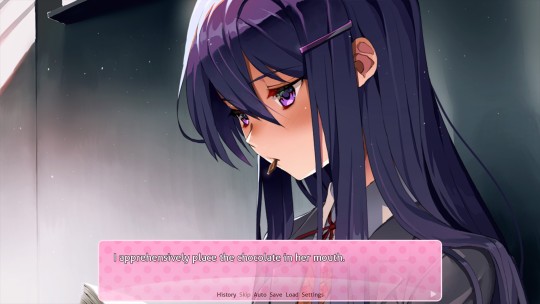
(Yuri was my favorite.)
#archon reviews#review#video games#video game#spoiler-free#dating simulator#doki doki literature club#ddlc
1 note
·
View note
Text
The Archon’s Review of Dominions 5: Warriors of the Faith
Dominions 5: Warriors of the Faith is a fantasy turn-based strategy game created by indie developers Illwinter Games. The world was once well-ordered and prosperous under the auspices of the supreme god, the Pantokrator. However, the Pantokrator has vanished from the world, and many divine or infernal beings have risen up to take the supreme god’s place. Now, as one of these Pretenders, you must guide your nation in their wars against all the other nations, and thus claim the Thrones of Ascension, thereby achieving godhood!

So, fair warning beforehand: this review is basically just me sucking this game’s dick for a few paragraphs on end. So if you don’t want to witness hardcore human-on-videogame fellatio, maybe don’t read this one. Sorry lads/lasses/non-binary basses.
So, Dom5 has the whole “God’s gone away” background story, but there’s no overarching campaign. Instead, it’s more like a game of Civilization; you play each game as its own instance, and when you win, you can boot up another one, assuming it’s not 4 am. Or assuming it is 4 am. Either way. This helps the player create their own narrative about their Pretender character, and while the Dominions roleplaying communities aren’t very robust, that doesn’t mean it isn’t fun to create and really play as a god. Basically, because the scope is epic, you get invested, but because each game is insular, you can decide how your character and how their nation operate, in very much a freeform manner.
The thing that I like most about this game is that it may be one of the deepest games I’ve ever played. It’s got strategic depth aplenty, and despite the lack of a story campaign, there’s depth of lore as well.
In Dom5 the one thing that may stick out is how many options and how many choices the player has to make. First they’ve got to pick a technological era to play in, which may alter, remove, or add nations for the player to choose. Then, they’ve got to pick a nation to play as, of which there are asstons. Then, they’ve got to pick the terrestrial form of their Pretender, the choices for which are more-or-less unique to each nation, and they’ve got to define what sort of dominion that god holds and what magic they know and what blessings they can bestow on their sacred soldiers.
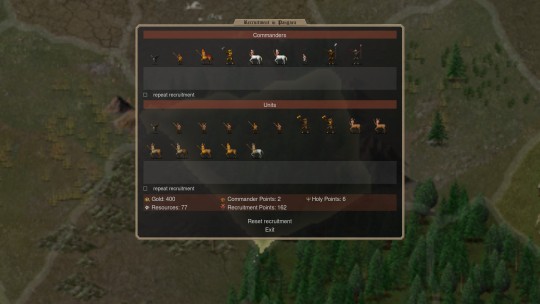
(This many unit choices for like, 25-30 playable factions for three different technological eras. And this isn’t even taking into account the magic choices. It’s a lot.)
This allows for plenty of strategic possibilities, and you have to take into account your chosen nation’s qualities, and your opponents’, so as to choose the best Pretender options and the best army compositions. You should also take into account your choice of magic spells as well as your opponents’, because global enchantments can be simply game-changing.
Speaking of magic, it may be one of the most fun magic systems in a strategy game. There are two types of spells: combat and ritual, and both feel awesome. Watching fireballs streak across the battlefield is always fun, especially if you’ve got a large cadre of wizards all flinging spells one after the other. Ritual spells, on the other hand, are another matter entirely. This is where having a high-level wizard, or a powerful god can come in handy. Ritual spells include the ability to summon entire armies, create a second sun, engulf the world in darkness, or, if you happen to be feeling particularly sadistic, you can even accelerate the aging of all living beings in the world so that they die faster. The magic in this game feels all powerful and utterly amazing.
Now, my all-time favorite aspect of this game is the depth of lore. Literally every nation has oodles of flavor text over all its generational iterations, and each unit and each spell has it’s own flavor text. One could spend literally hours reading the flavor text on each thing in the game. The flavor itself borrows heavily from real-world mythologies, all doused with a heavy helping of what the sages call “Rule of Cool”. Some of it gets pretty explicit, with many civilizations named directly after their real-world counterparts, such as Tír na nÓg, or Rus. Some are slightly more oblique, such as Mictlan, which is an analogue for the Aztec empire, and Ermor, which you can figure out if you remove the first R and flip the resultant word. There’s even an R’yleh civilization, which only gets more and more fucked up as it progresses through its iterations.

(See all that text in the topmost paragraph? Yeah, it’s not at all unusual for units to have that much flavor text, sometimes even more. This game’s got a lot of reading for those interested.)
One detail I dig is that there’s a sort of amorality coursing through the narrative, the mechanics, and even the cosmology of the game. You are expected to run an efficient, powerful, and overall grandiose war machine, as your goal is nothing short of godhood; nothing else matters. You need to sacrifice those virgins to power your spellcraft? Go right ahead, no-one’s judging you. You need to pillage those provinces for money? Hey, they’re your own citizens! You need to force the world’s population to age rapidly until they’re all nothing but dust? Awesome, fuck the haters!
You see, I once played a game called Total War: Empire. It takes place in the age of empires, when men were calculated as mere numbers. They were not flesh and blood people, but guns, horses, and cannons. That game did a great job getting me into that mindset, wherein each casualty was merely another bullet-shooter to be replaced in pursuit of my goal of the domination of Europe. Dom5, in comparison, takes this mindset to the extreme. When not engaged with the flavor and depth, I was churning out soldiers as if from an assembly line, before sending them into battle, and very likely, to their deaths; or at least, to their crippling. See, each time a soldier or creature is struck in combat, it has a chance of getting an affliction, some of which can be quite debilitating. Does this prevent me from including them in my armies? Of course not! Every body is useful. Dom5 posits that the goal of godhood comes before everything else; the thoughts and problems, and therefore, the morality of a god, are all so far removed from those of mere mortals that they cannot be judged for their atrocities, or even for their benevolence. Hell, you don’t even intervene directly in your subject’s lives; that’s determined by your dominion. Basically, Dom5 states that your goal is all that matters; you can be good to your subjects as far as the game allows, or evil to them in great measure, but no matter what, you must achieve your objective, or else all is lost.

(Do you see the ladies in white surrounding the two antler-guys in the back? Yeah, they’re probably going get sacrificed for magical powers. And it’s likely that I will feel nothing for it.)
So, after a great segue, let’s talk about the problems this game, does admittedly have (if we’re still using the fellatio metaphor, this is me admonishing the game for shooting off in my hair while absentmindedly stroking the game’s dick gently. This blog may not be for children). For one, the game’s learning curve is total crap. The tutorial is in the “tools” menu for some reason, and even after finishing it, unless you’re a series veteran, you may struggle to pick up all the concepts. And this is quite a heavy game. It’s improved considerably since Dom4, but even still, new players may be turned off by the terrible learning curve.
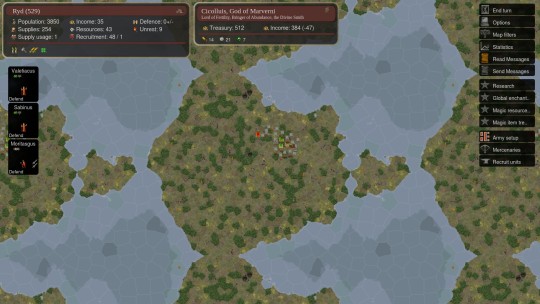
(The game’s UI, plus a lovely shot of a game’s map. While cluttered, the UI can be intimidating to explore for people used to Civilization or Total War.)
In addition, the graphics leave a lot to be desired. We’re talking in bits here, not polygons, and not very many of them, at that. Each sprite has only two states, “static”, and “action”. Of course, all this is to compensate for the literal hundreds of soldiers and dozens of particle effects that can appear on screen at once, and the tonnes of different entities on the overworld map and the AIs controlling them. This game’s got a lot going on.
Speaking of combat, it claims to be real-time (while the administration and map movement is turn-based), but as someone who played Dom4, which was turn-based, I don’t see much of a difference between the two. This is because the combat system is actually pretty interesting. Instead of controlling your soldiers directly, you assign them pre-programmed orders, which they execute to the best of their abilities upon meeting the enemy. This requires you to think of a strategy beforehand to suit your nation’s strengths and weaknesses and those of your opponents. After you engage in combat, you can watch the replay, which is where you can actually see what happened in real-time. It’s actually really rad to see your hordes of warriors carving a swath through your opponent, and your mages slinging spells overhead. It’s like watching Lord of the Rings, except pixellated and probably with giants and sea monsters instead of dudes and orcs.
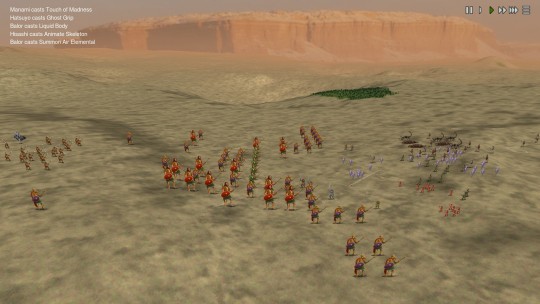
(A scene of my Fomorian giants surrounding and obliterating a horde of summoned creatures. This will only be one battle in an uncountable series.)
One last thing before the ending wrap-up: I suppose I should make it known that I am quite self-aware, and I know that sacrificing virgins to power blood magicks, and enslaving people to fight in your wars are all horrible things in real life. In a big way, one of the things I like about this game might be one of its biggest turn-off to some people. So I suppose if you’re sensitive to the concepts of violence toward women, enslavement, and, but limited to, cannibalism, maybe don’t pick this one up. I’m not actually joking about cannibalism, that happens.
I like this game. A lot. So much that I’m actually having trouble describing why I like it. Like, I’ve described elements about it that I like, but writing this out, I realize I haven’t gushed nearly as much as I wanted to or thought I would. Maybe I’m more a melancholic person that I thought? In any event, I guess I should apologize to the game; it’s going to bed with a mild case of blue-balls. In all seriousness, I totally recommend this game to anyone, especially people who like ancient mythology and turn-based strategy. I will probably play the fuck out of this for a long time to come, assuming they don’t release Dominions 6 any time soon.
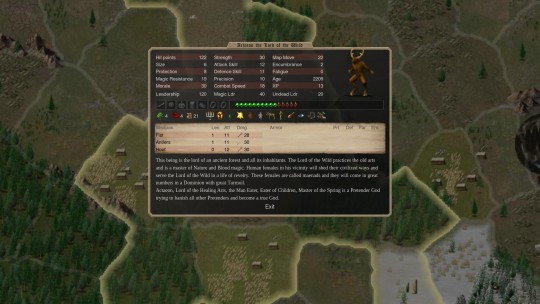
(Actaeon, Lord of the Wilds, and the Most Ironically Named. He was always one of my favorite gods to play as.)
#archon reviews#video games#video game#review#fantasy#turn-based strategy#dominions#dominions 5#dom5
0 notes
Text
The Archon’s Review of The Shrouded Isle
The Shrouded Isle is a village management-cum-cult simulator created by Jongwoo Kim, Erica Lahaie, FX Bilodeau, and Tanya Short; and published by Kitfox Games. For the past 497 years, your village has adhered to the tenets of your awesome murder-cult. It is written that after 500 years, if you and your people have kept the faith, the god Chernobog will rise up from beneath the waves and save the chosen. In the meantime, you must choose a villager to sacrifice each season, and you must manage your relations with five different aristocratic families, and you have to make certain that your people don’t inadvertently sink into sin and depravity.

This game is certainly an interesting one. It almost seamlessly combines the grim feeling of being in a Lovecraftian cult, the strategy of a management simulator, the deductive reasoning of a detective thriller, and the expectation of failure and repetition of a roguelike.
The initial premise seems pretty simple. You have to pick one advisor from each of five different noble houses, each tasked with upholding a different virtue. You do this at the beginning of each season, and at the end of each season, you have to choose one of your advisors to sacrifice to Chernobog.
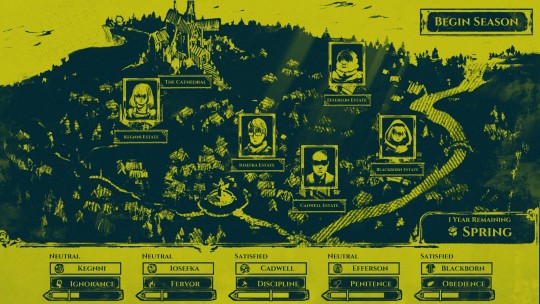
^(My little village, with all my advisors picked out for the season.)^
Now, you don’t want to sacrifice people arbitrarily, as, whenever you sacrifice someone, the virtue that they most exemplified begins to slip, as the people lose faith in Chernobog and in you. So how do you choose your sacrifices? Well, that’s where the detective elements come in.
Each character in the game has a virtue and a vice, each of which are hidden from the player at the start. There are a few ways to reveal what they are. First, if a noble house likes you enough, they’ll let you perform an inquiry, learning more about one of their members. Second, you can infer from little stubs the game gives you about each character, such as “As a child, he was a competent doodler,” or “She once challenged Lord Cadwell to an eating contest... and won!”. These will at least tell you the nature of the virtue/vice the character has. Third, you can let them perform a function for you on your council. If they are particularly detrimental to a particular virtue, then they likely have a major vice of that category. For example, if, in the course of their duties, your councilor causes the virtue of Obedience to slip severely, it may imply that their vice is a major one concerning Obedience.

^(Obey this, heretic!)^
So you have to sacrifice each person with a major vice (”sinners”), and make sure to not let each virtue drop too much while also making sure not to piss off any of the noble houses too much. There are a couple of complications to this mission, however. First off, when you sacrifice your first sinner, Chernobog sends you a dream demanding a greater encouragement of a specific virtue, and the life of a specific sinner. This can cause problems if you happen to get advisors who tank that virtue. In addition, whenever you sacrifice someone, the noble house they came from becomes annoyed with you. If you pick the same house sequentially, they get really quite irate, which can lead to a loss. This can be especially troublesome if you discover multiple sinners in the same house, as your instinct will be to sacrifice them sequentially, but that’s a bad idea.
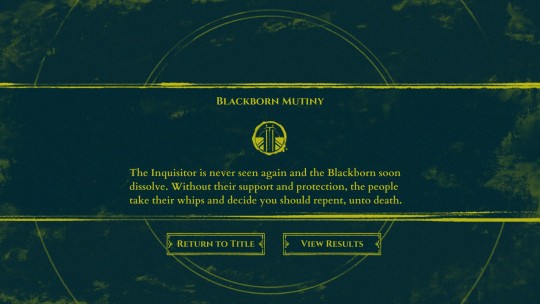
^(Does protagonist is unrepentant?)^
So that’s the mechanics. Do i have any actual problems with the game? Well, sure. Basically, because of the random elements of the game -- each time you boot up a new game, it randomizes which characters have which virtues/vices -- it is difficult to form a decent strategy on one’s own. You feel as though the game is against you somewhat as you essentially are forced to guess which characters are worth keeping and which are worth sacrificing. This may actually be apt for a story about a Lovecraftian cult, but it doesn’t make for non-frustrating gameplay. However, the script flips after you figure out the right strats (or if you do as I did, and look them up). Once you figure out how to achieve the perfect run, the game becomes engaging, but not altogether challenging, and the replayability drops precipitously.
The aesthetics I really dig. The game has a grim, nautically grimy art style, with lots of dark colors contrasted against sickly light ones. As for the music, sometimes it’s jangly, sometimes it’s gloomy, and sometimes it’s foreboding and dark, but it always conveys a sense of wrongness, of an edge that you are very close to at all times. It fits, honestly. The one thing I really liked about the character designs was the the sheer eeriness of them. They all have this sort of doughiness to them, although some of them appear lean and malnourished as well. But the most striking feature of the characters is their complete lack of eyes. It makes them especially creepy.
I wish I could say more, but the game is quite short, so there’s not much more to say. Would I recommend it? If you’ve ever wanted to be a cult leader, or if you think the idea of being a cult leader is neat, then yes. Like I said, there’s not much replayability to it if you get the perfect run, but there are apparently five other endings to the game, each one depending on certain parameters that have to be met before the final season. Also, there’s apparently some DLC coming out soon, so I might have to pick it back up for that.

^(He seems like a salvific figure. Just like the J-Man.)^
7 notes
·
View notes
Text
The Archon’s Review of Sonic Forces
Sonic Forces is a 3D platformer developed by Hardlight and Sonic Team as part of the venerable Sonic the Hedgehog franchise. These are dark times for... wherever the hell the Sonic the Hedgehog characters live. Dr. Eggman has taken over the world, and a new horror, a beast named Infinite, has slain Sonic himself. There is still hope, however. Knuckles the Echidna has formed a resistance movement, and though its gains have been minuscule for now, their fortunes are about to turn. You, the player, are a new recruit for la resistance, known simply as “The Rookie”. And if that nickname doesn’t get on your tits within the first twenty minutes or so, then you must be a machine or something. You will be the catalyst that saves this world from robotic annihilation. Also, dress-up. So much dress-up.

Deviant-artists, rejoice! You can finally make your very own Sonic-OCs-do-not-steal, and even play as them! I would be lying if I said that this singular feature wasn’t what initially drew me to Sonic Forces. Hell, the concept actually got me kinda excited! Of course, if I wanted to play Sonic the Hedgehog: Dress-up Edition, I could Google it and probably have a competently executed flash game appear, so how’s this game actually do?
Well, we’ll begin with a rather sad statement. That is, you only really play about a third of the game as your OC. And that may be a generous estimate. Otherwise, you play as either Sonic, or the old-school Sonic from Sonic Generations. Sometimes you play as both your OC and Sonic; so as to combine your powers to perform a rare and dangerous team dash scripted section thingie.
Speaking of your OC’s interactions with Sonic the Hedgehog, they have some. And this actually ties with one of my fundamental problems with the game’s story; it characterizes your OC for you. Sadly, the character they decided was “Loves Sonic so huggy muggy much.” Honestly, the amount of time your OC spends thinking about, or hanging out with, or taking inspiration from Sonic the Hedgehog grates on me quite a bit. It also prevents your OC from being their own person somewhat, as most of what you see of their personality is filtered through this veneer of hero worship, and I mean, I like Sonic and all, but I don’t think my OC would like him as much as the game makes it out.

^(Pictured: Sonic helping my OC from beyond the Shadow Realm.)^
What, you want to know how each of the playable characters works? Well, it’s fairly simple. If you’ve played Sonic Adventure 2 or Sonic Generations, that’s regular Sonic. If you’ve ever played a 2D Sonic, that’s basically how OG Sonic rolls. The OC is a bit trickier though; superficially, they play like regular Sonic, going fast and platforming. However, the OC has a device called a “Wispon”, which allows them to swing on certain parts of the environment, Saul Spiderman-style. In addition, Wispons come in various elemental flavours, and each one has an attack ability, and a platforming ability that makes certain parts of certain levels super easy. So stages where you play as your OC are half-Sonic, half-swingy-elemental-bollock.
I have one little nitpick concerning difficulty. There are two difficulty modes: normal and hard. But the game locks achievements behind the hard difficulty setting. Except the hard difficulty setting is really not that difficult. Like, Hard is normal and normal is easy? It’s a bit weeiird is all.
So how about that plot? I’ve got to say, it’s actually really, really dark. Like, darker than Shadow the Hedgehog. And the game just sort of takes on this dark plot by accident. As I mentioned earlier, Sonic is killed in the second cutscene or so. Except, he’s not dead, he was merely captured by Eggman... who then tortured him for months on end. The only reason Sonic was kept alive at all was because Eggman wanted him to witness the birth of the Eggman Empire before Eggman ejects Sonic into the vacuum of space! And all of this is relayed to the player with the same tone of voice as one might relay a sad factoid to a friend. And Sonic himself doesn’t seem all that phased by the relentless torture. Like, damn, great fortitude on Sonic’s part, but it would be nice if the tone of the game reflected the seriousness of the plot.

^(Also, there’s a Death Star -- Sorry, Death Egg bit.)^
In fact, the entirety of the game has this very militaristic overtone that I actually found very interesting. The entire world seems to be inhabited by animal-people, all of whom seem to be engaged in a death-struggle with Eggman’s robot army, and (SPOILER WARNING) Eggman’s over-arching plan is essentially genocide. Like, this may very well be the most threatening Eggman’s ever been. If memory serves, the more recent Sonic games usually have Eggman being a secondary villain in front of some big, bad, true ending villain. (SPOILER WARNING CONTINUES) But here, it’s the other way around; Infinite is built up as this big badass, with reality-warping powers extraordinary, but he gets wreked near the end after a mildly frustrating chase-fight. After that, you fight Eggman, who has constructed a truly frightening mechanized horror, and as far as multi-stage mech bosses go, his transition from stage 1 to 2 is actually a bit grotesque. I’ll admit, this may have been because of my low expectations, but I was actually impressed with Eggman in this one. (SPOILERS OVER)
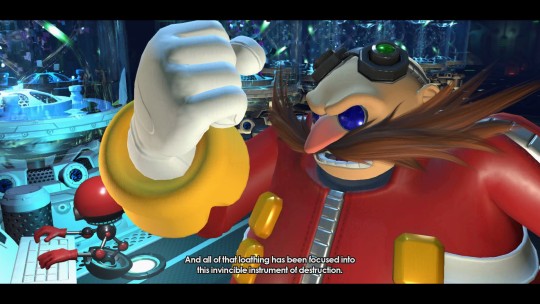
^(Like, I think this is the first time in recent memory that Eggman actually professed to hating Sonic with as much passion as he does here.)^
Another peculiarity, albeit a minor one, is that there are no Chaos Emeralds, or a Super Sonic, both of which are usually series staples. Instead, there’s a “Phantom Ruby”, which turns out to be the source of Infinite’s powers.

^(Plot phlebotinum.)^
But enough of that interesting plot nonsense; you want to play dress-up with your very own Sonic-OhSee-Donut-Steel. You acquire new options for dress-up and new Wispons by completing missions, such as finishing stages or getting a certain number of medals while playing as a particular species. However, the options for customization are a bit... limited. There are only 7 or so species to choose from, and only a few different eye shapes and voices. As for clothes, there’s enough variety to keep you going for one go of the main campaign, but after that, there’s little else to acquire. Also, I feel that they could have condensed certain clothing options into a single article, while allowing the player to choose the color for their clothes, instead of it being pre-set per article.

^(My Original Character, Greg the Dog. He will later replace that fedora with a tri-corn hat.)^
I have one more problem with the gameplay before the ending wrap-up. Basically, the 2D Original Sonic sections work well, being evocative of ancient Sonic the Hedgehog stages; however, every so often, the regular Sonic stages and the OC stages will shift from full 3D to 2D. Unfortunately, they keep the same physics, meaning that most of the time, your character will go too damn fast, especially when they throw goddamn piss-taking, assaholic precision platforming sections at you. They’re not fun, not engaging, and not a test of the player’s skill. These sections are asssssss. Plain and simple. The number of times I fell into a pit while in 2D mode because I couldn’t curtail Sonic’s ridiculous speed is proportional to the number of blood vessels I burst in rage.

^(This part haunts my nightmares. That pod thing there in the center has no hit detection, and constantly shoots spike balls at you.)^
Also, Shadow the Hedgehog is in there somewhere. He’s not a problem; I just figured I should mention that he has a little 3-part prologue thingie. There’s no reward for beating it, it’s just kinda fun I guess.
Is Sonic Forces fun? Would I recommend it? Well, ask yourself this: Would you play as your Sonic OchSea Doughnewt Stale if you had the chance? If yes, then I would totally recommend Sonic Forces. Otherwise... I mean, it’s not bad, per se, The plot’s a pretty big deviation, which I found interesting. But the mechanics are... okay. I’m not going to keep playing because I already beat it. The adventure of Greg the Dog is over. It’s fun while it lasts, but afterwards, I wouldn’t think about it too much.
Hey, this part is a later addition because I messed up and forgot to include one more point. That is: the music in this game is the most buttastic butt rock I’ve ever heard. I have a soft spot for butt rock; I Am... All of Me by Crush 40 is one of my favorite songs, and the cover of Live and Learn by FamilyJules and Jonathan Young is one of my favorite works of theirs. But this music... Arrrgh, is it ever trite. Like, Think of a middle schooler trying to write music for Crush 40 and having it sung by another middle schooler, and you’ve basically got the music for this game. Is bad.

^(Best shot of Infinite I could get.)^
6 notes
·
View notes
Text
The Archon’s Review of E.Y.E: Divine Cybermancy
E.Y.E: Divine Cybermancy is a first-person shooter with role-playing game elements created by Streum On Studio. It is the year 15 of the New Era (About 2395 CE), and the Federation (It’s always, always a fucking federation, isn’t it?) has total and dictatorial control over ~1,200 worlds. However, things are not going well: violent crime and piracy are not only rampant, but absolutely endemic, even expected on most Federation worlds. Strange and terrible creatures known collectively as the Metastreumonic Force have ravaged any world already desolated by human industry. Megacorporations rule pretty much everything. In the midst of this horror and chaos, a shadowy and clandestine group called the Secreta Secretorum has returned to prominence. Once, they were demon hunters and mystics, fighting against the Metastreumonic Force alongside the Federation, but now horrified by its total control over so many worlds, they have decided to rebel against them, using the chaos of looter bands and Force attacks to their advantage. However, things are not going well for the Secreta either. The group is split by factional infighting, as the Culter Dei and the Jian Shang Di groups each struggle for power and influence within the Secreta Secretorum. In this moment, the Culters have made a move to strike at “an influential Jian mentor”. You were assigned to a special task force sent to complete this mission, but you wake up in a cave, amnesiac, and must piece together your past, the plot, your loyalties, etc. As a direct result of your amnesia, people assume you’re stupid because you ask basic questions. Are you stupid? Only one way to find out.

I swear to the heavens that the above splash image is not a Space Marine.
So, another FPS, this one with the RPG mechanics that were really popular with FPS’s for a while.This is one of those games where I seem to have more bad to say about it than good, and yet I end up enjoying it anyway. See also: Shadow the Hedgehog.
So how about that visual aesthetic, eh? Basically, take Warhammer 40k, Shadowrun, Crysis, and whatever other cyberpunk/dystopic sci-fi you wanna think of, toss it all in a blender, and Divine Cybermancy is basically what you get from it. Sadly, while they were busy stealing elements wholesale from wherever they could, they decided that having interesting or multi-colored backgrounds was overrated, and that having interesting and distinct character models was more so. This actually makes it a little bit difficult to determine which enemies have which weapons and abilities. In fact, there are like, 3 character models per faction? Maybe? In addition, the lack of diverse backgrounds makes it a little bit difficult to know where you’ve been before in a level. All in all, while the aesthetic is interesting prima facie, it rather quickly becomes a mass of dull colors and confusing visuals.
Quick, semi-related note: the dialogue translations are a little bit not-the-best. I had originally thought that the game was translated from Russian, but I later read that it was translated by a Frenchman who knew no English at all. So, either this mysterious Frenchman is translating from Russian into English, or from French into English. Either way, the translations are impressive... for someone who speaks no English. Some of them do get really weird later on though, so... eh, we’ll give the translations a C+ and move on, shall we?
Speaking of men, this game is an absolute sausage fest. Like, there are literally no female characters to speak of, except for a particular female enemy type among the aforementioned Metastreumonic Force. I mean, c’mon Streum On Studio, even W40K has the Sisters of Battle, and I’m sure Crysis had a lady or two. Although... almost every character has a full helmet and body armor. So I suppose, they could be women underneath all that armor. But I know for a fact that almost all the main characters are dudes.
Speaking of dudes, the tutorial is rubbish. It’s a basic level through a cave and then a sewer system, and every time a new mechanic comes up, the game will helpfully prompt you to press the T key to bring up the list of tutorial videos. Really sloppy, actually, when you could easily build a tutorial into a game like this. Although, it controls more or less like a standard FPS, so I don’t begrudge it too much, I suppose.
Speaking of grudges, there is no functioning save system. Like, at all. The game supposedly auto-saves your progress at the start of every mission, and also at the mission’s conclusion, but missions can be really long and arduous, and even then, I have encountered at least one glitch (I imagine it’s a rare one), which deleted all my progress and booted me to just after I finished the tutorial level. Without any explanation. Or warning. It was a very trying moment for me. Manly cyberpunk tears were shed.
Speaking of other game elements to pick at, if that exposition up there made no sense to you, don’t worry. It confused they heck out of me as well, but I sorta liked it anyway. Not everyday that you see the the obligatory human Federation as the bad guys. Hell, their footsoldiers are literally the Helghast from Crysis. PEOPLE WHO MADE CRYSIS DON’T SUE THESE PEOPLE, ETC. That said, the plot your character goes through is a bit of a mess, at least, to begin with. You start in a dream, where you learn you’ve killed your mentor, and then you get dropped into the beginner cave, and everyone acts like you should know everything about this world already, but you know nothing, Jon Snow. This results in compounded confusion, especially since the historical archives your allies give you access to only detail the past millennia, not really immediate events. Regardless, I’m sure the plot pans out... somehow.

^(I’m putting thus here only to prove a point about the visual similarities between these enemies and the ones in Crysis. You guys, pleeeeaaaase don’t sue Streum. It’d make me sad.)^
Now, some of the things I’ve described are not without their qualifications. Por exemple, while the visuals are generally dull, are some genuinely impressive shots one can get if they position themselves well. The game is a bit like having a lovely view out your living room window... of a totally urban environment created by someone who subsists on cigarettes and cyber-spite.
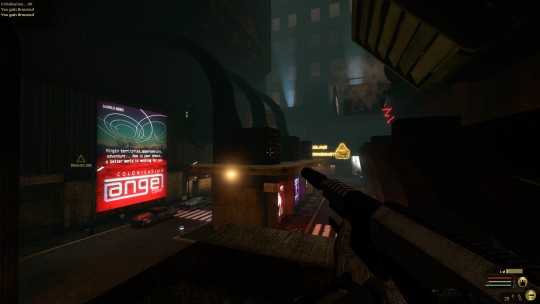
^(A vibrant, dystopic paradise...

... the halls of power in an ancient temple...
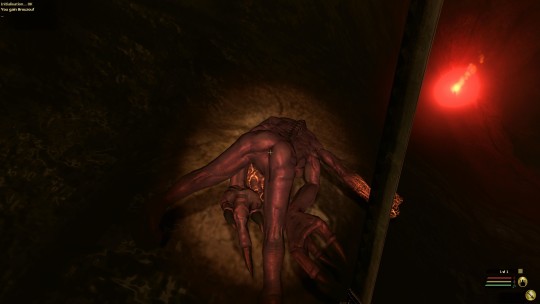
... and choice monster ass. What more could you ask for?)^
Even all that is dressing and crust for the moment-to-moment gameplay. And that gameplay is actually quite entertaining! It facilitates a variety of gameplay styles. You wanna be a cold sniper, casually making headshots against gormless assholes? Go for it! Wanna be a psy-wizard? Do it! Tech-berserker? The world is yours! Hacker extraordinaire? Enemies are hackable; hack ‘em all! Each of those gameplay styles is not only viable, but entertaining as fuuuuuuuuck. Getting regular headshots made me feel like a Shinigami, and when I was done with that character and wanted something more hands-on; well, let’s just say the transmutation of monsters into monster corpses was made all the more enjoyable with the aid of my exploding sword.
The RPG elements work well enough, and are pretty bog-standard. You get experience points for killing enemies and completing missions, and every time you get enough, you gain a level, giving you 3 skill points to distribute among your many abilities. In addition, you can equip a number of items, each of which take up a certain amount of space in your inventory. These items and your armor determine, along with your agility stat, your movement speed.
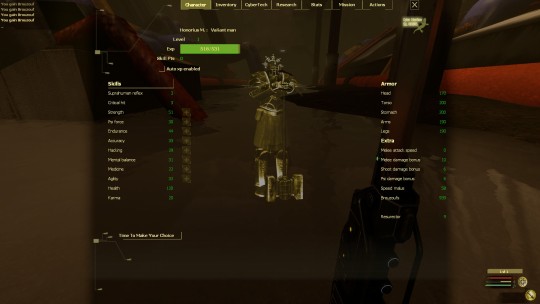
^(My tank character’s sheet. Stats on the right, derivatives on the left.)^
You may also invest in cybernetics which increase your stats or give you special abilities, or in psionic powers which are essentially magical. Each of these cost mone -- Oh, I’m sorry, brouzoufs -- and while they seem really cool, I often found that my first brouzoufs went into research. Oh yeah, you can research things in this game. These researches can grant you the use of new items, or improve your stats, or merely unlock new research topics. Really, there’s a lot to spend your resources on, whether it’s skill points or brouzoufs.
Nəticədə, I had a hard time with this game. I loved the pizza that was the gameplay, but not as much the toppings that were the ancillary bits. I’d recommend it to very patient sci-fi/cyberpunk fans, mostly. If you’re patient with the game’s faults, the game will prove quite an enjoyable experience. I would only return to playing it if I had a lot more time on my hands, honestly.

^(Of course, the best thing about the game are these friends.)^
#archon reviews#video games#review#sci-fi#cyberpunk#fps#first-person shooter#rpg#eye divine cybermancy
1 note
·
View note
Text
The Archon’s Review of Impossible Creatures
Impossible Creatures is a real-time strategy game developed by THQ Nordic and Relic Entertainment. You play as Rex Chance, a former reporter formerly working on the Spanish Civil War. Rex gets a letter from his father, one Dr. Eric Chanikov. Chanikov begs Rex to come and see him on an island in... the ocean somewhere. Rex does not find his father, but instead finds a monstrous tiger-mantis hybrid in a jar, and then one out of a jar. This horror chases Rex out into the snow, where a group of the hybrid beasts surround him, and he meets Upton Julius, Chanikov’s former partner and professional megalomaniac. Upton tries to kidnap Rex, but Rex is rescued by Dr. Lucy Willing, an action scientist with a flying train-lab. Together, the pair try to find Dr. Chanikov and unlock the secrets of SIGMA technology’s creature combining power.
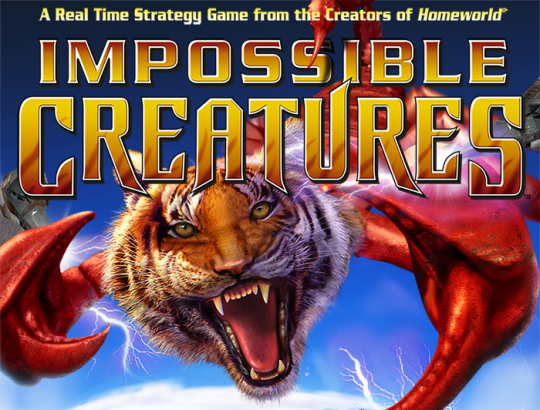
Another late review, another RTS review. I was pleasantly surprised to discover that this one was made by Relic, the Dawn of War dudes. Seeing as how I really liked Dawn of War, I determined that this one would be pretty rad too! I was more or less right.
To start, the game has this sort of diesel/steam/electric-punk aesthetic going for it, with all the structures looking as though they’re held together by subpar welding and the very eau de la Industrial Revolution; find it today at your local Macy’s. I sort of dig this aesthetic, and thought it cohered very well with other elements of the game.

^(This is where your creatures pop out...
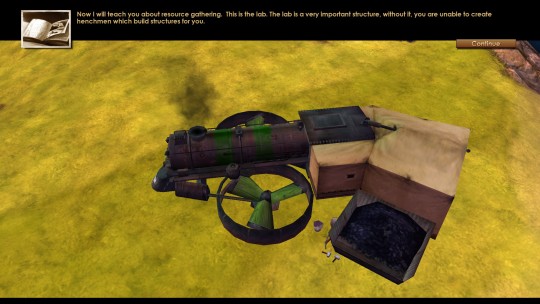
... and this is your train-lab-base. Charming, no?)^
Now, as you may have guessed, the core mechanic of the game is stapling creatures together to form crazy-powerful warbeasts capable of the destruction of your enemies, who are doing the same. There are 50 different creatures to combine, more if you play with the Insect Invasion expansion that comes with the Steam release. Seeing as how you can staple together the various parts in different ways, this gives us literal shittons of combinations to pick from.

^(This is Eric. He’s a Baboon/Cheetah, from before I gave my creatures awesome names)^
And this gives us the role this game plays in our entertainment-sphere. Some games want to tell a great story. Others want to be awesome multiplayer experiences. Still others want to explore newfound game mechanics. Impossible Creatures may be one of the best “for fun” games I’ve ever played. The central mechanic of combining creatures is just plain fun! Like, you could spend a day to a week trying to find the most optimal creature combos for your bed-ridden blueprints, but you could also spend hundreds of time units just sticking creatures together just see what you get. I spent a comparable amount of time just dicking around as I did with the actual campaign. What did I find out? Sticking a fish head on a giraffe body is horrifying, and giant bees with the head of any non-bug is terrifying.
Speaking of that story, it kind of doesn’t make much sense. The antagonist, Upton Julius, wants to use the SIGMA technology to take over the world (insert obligatory M. Bison quote here). But I mean, even if the animals are buff as hell and bigger and meaner and more obedient than they might otherwise be, the armies of the world still have guns, which I imagine would be very effective against animals. In fact, the standard defensive turret, the Sonic Turret, is kind of daft, as I imagine bullet turrets would work just as well. Also, the story makes out that Chanikov’s research (that being SIGMA itself) was largely ignored by the scientific community. Ahem, special message to the writers: Are you lads fucking daft? Do you think that someone could invent fucking animal hybrids using DNA samples and electricity and coal and no one in the scientific community would care? I think not. I think that everyone would care a lot. Because c’mon, fucking animal hybrids! Jegus.
Now, the mechanics of the campaign are actually quite interesting. In many RTS campaigns, you’re given new mechanics to work with piecemeal, just sort of acquiring them for freesies over the course of the campaign. There might be a mission or two dedicated to getting historically or strategically important technologies or troops, but otherwise, they just sort of appear to create a nice, even learning curve. In Impossible Creatures, however, There’s a very real emphasis on discovery and active acquisition of new play elements. You send out Rex to gather new specimens for combining, and Lucy to gather schematics on enemy buildings so that you can build them. There’s often at least one building a mission, and several specimens to find to boot. This is a neat deviation from the norm, at any rate.

^(Mountain Lion get!)^
Now I do have a couple of issues. The first is that I’m not entirely certain as to whether or not the depiction of the Inuit and African natives of the islands is racist. Like, it seems to get slightly more racist as the game goes on. At first, Rex’s condescending attitude toward the natives is met with a dry wit that I found hilarious, especially since it averted the whole “mighty whitey” thing that I was sure was going on. But then later on, when an African native cried out in a mystical ululation that caused the animals to disperse, I thought, “Yeah... that was almost certainly some kind of racist”. Also, all the natives, no matter the aesthetic or implied ethnicity, have exactly the same face and voice actor. This was probably a side-effect of budgetary constraints, but it creates some unfortunate implications.
Another thing is that because of how the creature combiner is balanced, it is entirely possible to accidentally create a massively overpowered creature (Archerfish head on a Giraffe body). It is also possible to accidentally create a massively underpowered creature (Front half Moose, back half Mammoth). You’ll probably want to look at some guides to figure out the best combinations, but really, just be careful, and look closely at stats versus resource costs.
Ի վերջո, Impossible Creatures is a game for someone who wants to play with an Endless Legend/Space game’s customization, but with a totally different aesthetic and with a completely different story and it’s about combining animals and it’s an RTS. So if that appeals to you... you strange person, this is the game for you! Will I be playing this again? Maaaaybe. I’d need to figure out how do make a decent endgame creature out of a Moose. Because Moose are rad.
Also! I don’t normally endorse mods, because I feel like I should be reviewing the product of the devs, rather than the products of other people. But this time, I will endorse the Tellurian mod.It adds a host of new creatures and balances out some of the other ones. In fact, the devs considered adding the mod as an official expansion, a la Age of Empires 2: The Forgotten, but decided against it because, supposedly, it’d make it harder for the mod devs to update it. Regardless, it’s a great mod for a decent game.

^(Hey there friendo, you readin a review or somethin?)^
1 note
·
View note